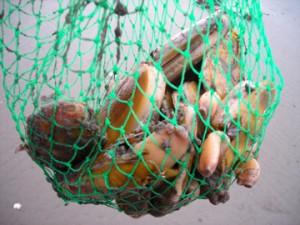HAB Event Response Program
The National HAB Office administers the HAB Event Response Program in cooperation with NOAA’s National Centers for Coastal Ocean Science. This program provides immediate support to help state, tribal, and local officials manage events and advance the understanding of HABs as they occur. Depending on need, the program may support or provide access to toxin analysis, data collection, training, technical assistance, and ship-based sampling. Modest funding is available to help defray the costs of immediate mobilization of response efforts.
During the past few years, this program has funded response efforts for multiple unexpected or unique HAB events. These projects were located across the country in response to both coastal and freshwater blooms, and included: studies to evaluate cyanobacterial bloom impacts in the northern Gulf of Mexico, investigation of the potential contribution of algal toxins to multispecies wildlife mortalities in the Norton Sound region of Alaska, monitoring activities in Lake Pontchartrain in Louisiana to assess the concentration and toxicity of harmful cyanobacteria blooms in the vicinity of areas used for recreation, and assessment of airborne toxins associated with intensive Microcystis blooms in the tidal Caloosahatchee River and adjoining canals around Cape Coral, FL.
Summaries of HAB Event Response activities funded by this program over the past decade are listed below. Information on how to apply for HAB Event Response support can be accessed on the NCCOS Response and Readiness for HAB Events webpage.
For more information or to inquire about funding support, email the HAB Event Response Program.
Past HAB Event Response Efforts:
In 2025, a record breaking 40 million metric tons of Sargassum flowed through the tropical Atlantic, with especially severe accumulations along Puerto Rico’s coastline. On June 30, 2025, the Puerto Rican Governor signed an executive order declaring a state of emergency and expediting responses to Sargassum. In support of this effort, the National Centers for Coastal Ocean Science (NCCOS) Harmful Algal Bloom (HAB) Event Response Program is funding an expansion of response activities for the remainder of the 2025 sargassum season through 2026. This will supplement ongoing efforts by the Puerto Rico Department of Natural and Environmental Resources (DNER) to manage the current Sargassum emergency and better prepare for future influxes.
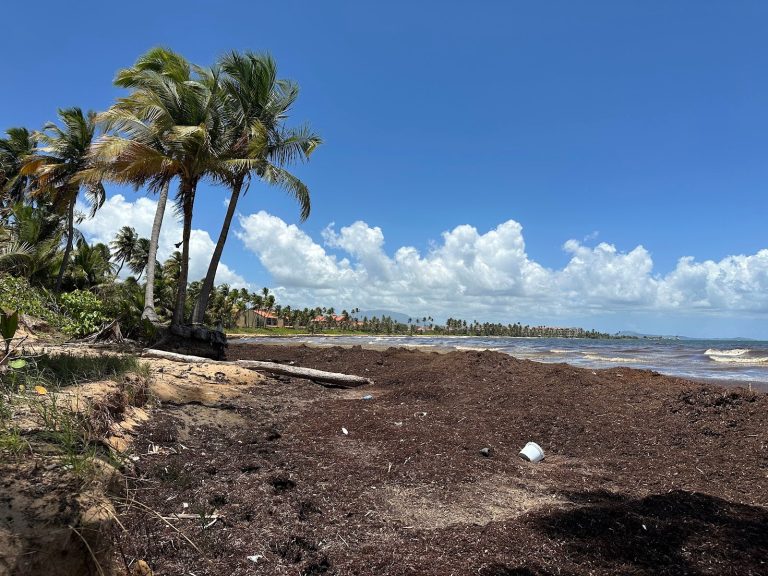
Accumulated sargassum along the shoreline at Candelero Beach, Palmas del Mar, Puerto Rico, undergoing decomposition. As it decomposes, the sargassum darkens in color and releases hydrogen sulfide, affecting local air quality. Credit: Mariana León-Pérez.
Large influxes of Sargassum are considered HABs when they inundate coastal waters and shorelines. Since 2011, the increased frequency and severity of Sargassum inundations have created challenges for coastal communities, wildlife managers, and commercial fisheries. Accumulated Sargassum can have considerable socioeconomic impacts: it deters tourism, damages critical infrastructure, deteriorates coastal habitats, and poses hazards to human health. Safe removal, disposal and proposed uses also pose significant challenges.
The NCCOS-supported event response is led by Mar Caribe Consulting LLC, with partners at the DNER and the Puerto Rico Coastal Zone Management Program, which will expand and complement Sargassum sampling efforts at six sites along Puerto Rico’s coastline. The results will help evaluate the likely abundance of Sargassum and water quality impacts during inundations and determine the levels of heavy metals within Sargassum biomass. The team will develop recommendations to improve future response efforts and inform guidance on safe handling and disposal and an approach to evaluate risks of alternate reuse strategies. This project also builds on another NCCOS-funded project by adding data on the volume of beached Sargassum in Puerto Rico to help validate improved Sargassum inundation predictions.

Sampling sites across Puerto Rico: red points indicate beaches where a comprehensive protocol will be applied, and yellow points indicate additional sites for heavy metals assessment. Credit: Mariana León-Pérez.
Local reports of Sargassum inundation in Puerto Rico should be directed to the Department of Natural and Environmental Resources. Learn more here.
NOAA is authorized to respond to harmful algal bloom events by the Harmful Algal Bloom and Hypoxia Research and Control Act (33 U.S.C. §§ 4001 et seq.).
For more information, visit the NCCOS Harmful Algal Bloom Event Response Program webpage. The NCCOS HAB Event Response Program is a national program that provides immediate support to help state, tribal, and local officials manage events and advance the understanding of HABs as they occur. For more information about the NCCOS HAB Event Response Program, contact nccos.hab.event.response@noaa.gov.
In July 2025, unusual mortalities of marine mammals and seabirds in and around Kachemak Bay, Alaska coincided with high bloom levels of the potentially harmful phytoplankton Pseudo-nitzschia. This event prompted tribal, state, and federal agencies to investigate the cause and assess potential human health risks. After ruling out avian influenza, the group is investigating whether the harmful algal bloom (HAB) produced toxins that contributed to these wildlife mortalities.
Blooms of Pseudo-nitzschia can produce the neurotoxin domoic acid (DA), which can accumulate in small fish and shellfish. Marine mammals and seabirds that feed on DA contaminated prey can suffer from severe illness or death. In humans, DA can cause amnesic shellfish poisoning.

Deceased adolescent female sea otter (left) and black-legged kittiwake (right) found on MacDonald Spit near Kackemak Bay, Alaska in July 2025. The cause of these wildlife mortalities is unknown. Credit: Michael Opheim (CRRC).
The NCCOS supported event response is led by the Alaska HAB Network in partnership with the Alaska Department of Environmental Conservation, Alaska Veterinary Pathology Services, Chugach Regional Resources Commission, Kachemak Bay National Estuarine Research Reserve, Seldovia Village Tribe, the U.S. Fish & Wildlife Service’s Alaska Maritime National Wildlife Refuge, the U.S. Geological Survey’s Alaska Science Center, and NOAA’s Wildlife Algal-toxin Research and Response Network for the U.S. West Coast. The support from NCCOS will facilitate the collection of additional samples for HAB toxin testing to assess and determine if HABs contributed to these wildlife mortalities and to better inform the public, subsistence harvesters, aquaculture farmers, and human health professionals of HAB risks in the region.
Please use the following hotlines if you notice anything unusual in Alaska:
Human health concerns – If you are experiencing symptoms of shellfish poisoning call 911 or your local health care provider immediately. Alaska healthcare providers who suspect or diagnose a disease that represents a public health emergency should immediately call 1-907-269-8000 during business hours or 1-800-478-0084 after hours.
Birds – For your safety, do not handle any sick birds or birds that are found dead. If you observe dead seabirds or encounter a sick or dead wild bird and the cause is not immediately apparent please call the U.S. Fish & Wildlife Service’s Alaska Sick or Dead Bird Hotline at (866)-527-3358.
Marine Mammals – For injured/stranded whales, seals, sea lions, porpoises, and dolphins call the NOAA Fisheries Alaska Statewide 24-Hour Stranding Hotline at (877) 925-7773.
Partner Links:
- Alaska Department of Environmental Conservation (ADEC)
- Alaska Harmful Algal Bloom (AHAB) Network, Alaska Ocean Observing System (AOOS)
- Alaska Maritime National Wildlife Refuge, U.S. Fish & Wildlife Service (USFWS)
- Alaska Science Center, U.S. Geological Survey (USGS)
- Alaska Veterinary Pathology Services
- Chugach Regional Resources Commission (CRRC)
- Kachemak Bay National Estuarine Research Reserve (KBNERR)
- Seldovia Village Tribe (SVT)
- Wildlife Algal-toxin Research and Response Network for the U.S. West Coast (WARRN-West), NOAA
Related Links:
NOAA is authorized to respond to harmful algal bloom events by the Harmful Algal Bloom and Hypoxia Research and Control Act (33 U.S.C. §§ 4001 et seq.).
For more information, visit the NCCOS Harmful Algal Bloom Event Response Program webpage. The NCCOS HAB Event Response Program is a national program that provides immediate support to help state, tribal, and local officials manage events and advance the understanding of HABs as they occur. For more information about the NCCOS HAB Event Response Program, contact nccos.hab.event.response@noaa.gov.
San Francisco Baykeeper plans to re-engage community volunteers this month with training provided by NOAA’s Phytoplankton Monitoring Network (PMN), operated by NCCOS, as a second season of harmful algal blooms (HABs) surveillance along shorelines and in marinas gets underway. The effort is one component of an NCCOS Monitoring and Event Response for Harmful Algal Blooms (MERHAB) project that is developing an integrated system-wide HAB monitoring program for the San Francisco Estuary.
Over the last decade, HABs have emerged as one of the highest-priority water quality management issues in the San Francisco Estuary, which includes the San Francisco Bay and Sacramento–San Joaquin River Delta. However, there is currently no sustained, coordinated HAB program covering the entire estuary.
Baykeeper volunteers are best suited to analyze water samples collected in the shallows along the shoreline and off docks, nearshore areas that can be incubators (or hotspots) for bloom-forming harmful algae species. Last year, working with MERHAB partners, including NOAA’s PMN, several possible hotspots were identified in the Central and South Bay regions, and a group of volunteers were provided initial training on established NOAA protocols in phytoplankton identification, data entry, and validation.
This year Baykeeper and NOAA PMN will kick off the 2025 summer monitoring
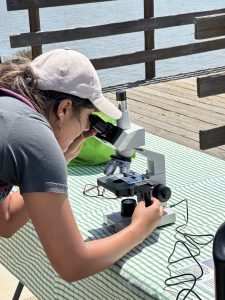
San Francisco Baykeeper fellow using a microscope to identify phytoplankton, 2024. Credit: San Francisco Baykeeper.
season by welcoming returning and new volunteers to a workshop at the San Francisco Estuary Institute (SFEI). New and returning volunteers will have the opportunity to learn and expand their skills in microscopy and photographic techniques, phytoplankton identification, and practice field sampling protocols. Volunteer sampling will help alert the research team and the California Department of Health to potential HAB threats throughout the summer.
San Francisco Baykeeper and its MERHAB partners — SFEI, USGS California Water Science Center, and California Department of Water Resources — are continuing a multi-year effort to combine community science monitoring with data from remote sensing, continuous water quality sensors, and molecular DNA-based detection methods. All data streams are also being integrated into an estuary-wide HAB dashboard that will aid in tracking water quality changes. The project will ultimately support efforts to manage nutrients to reduce the potential for future HAB events and address related water quality impairments in the San Francisco Estuary.
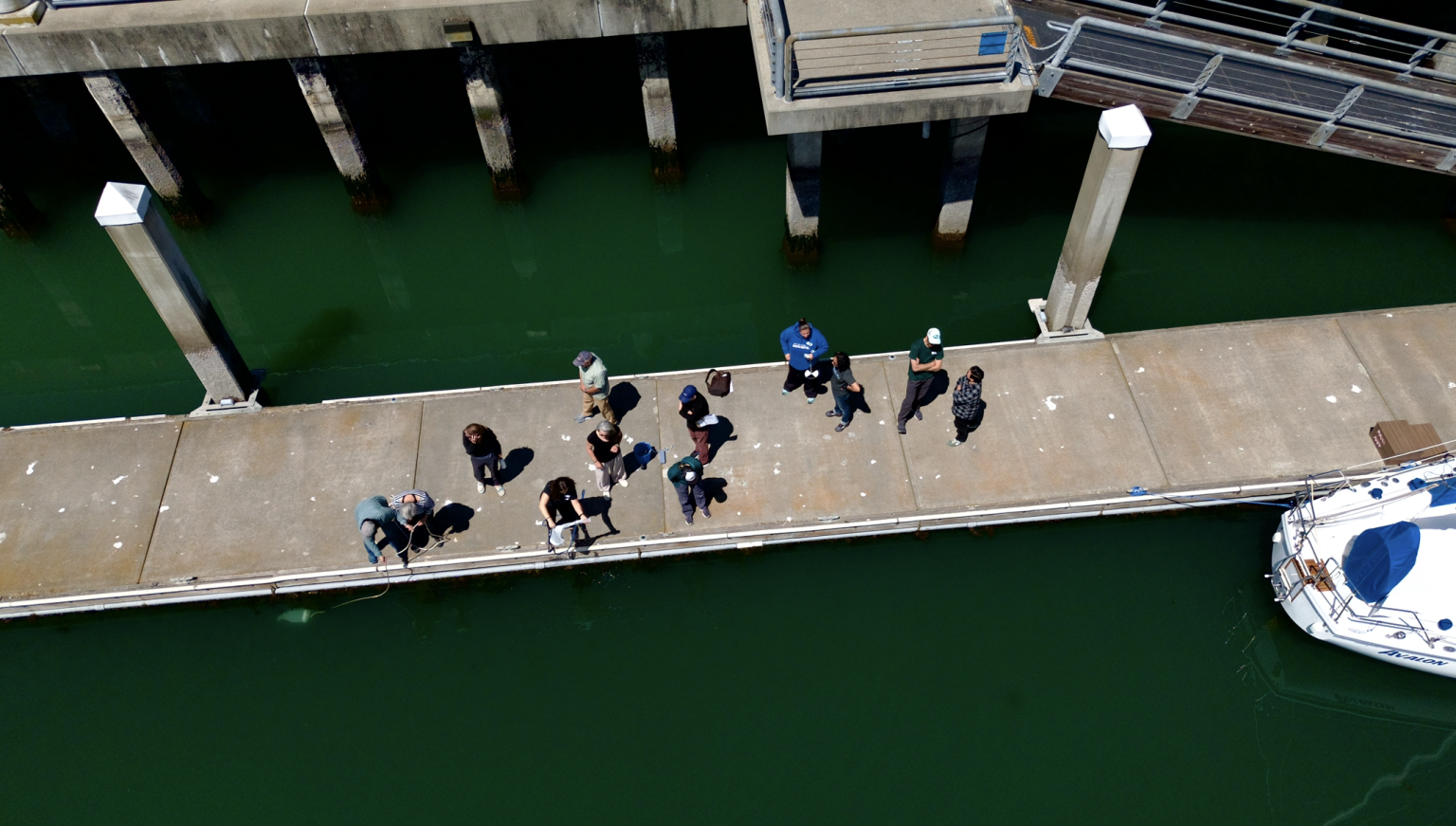
San Francisco Baykeeper volunteers learn to monitor and identify phytoplankton, 2024. Credit: San Francisco Baykeeper.
The workshop and related MERHAB project are authorized by the Harmful Algal Bloom and Hypoxia Research and Control Act (33 U.S.C. §§ 4001 et seq.) and the NOAA Authorization Act of 1992, Pub. L. 102-567 (Oct. 29, 1992); sec. 201(c), which directs appropriation for the NCCOS Competitive Research Program to augment and integrate existing NOAA programs, with a specific focus on improving predictions of coastal hazards and protecting human life and property.

Sample output from the SFEI HAB Satellite Analysis Tool. Estimates of cyanobacteria and chlorophyll-a calculated from satellites are displayed in the San Francisco Estuary system. These maps help guide field confirmation of cyanoHABs, assess primary production, and show the spatial extent of blooms and how bloom levels vary over time. Credit: California State Water Resources Control Board and San Francisco Estuary Institute.
For more information, visit the NCCOS Harmful Algal Bloom Event Response Program webpage.
A collaborative team of scientists and state managers from Stony Brook University and the New York State Department of Environmental Conservation (NYSDEC) are responding to ongoing harmful algal bloom (HAB) events in New York. The work is being done in partnership with NOAA’s National Centers for Coastal Ocean Science (NCCOS). Data collected by the team will help state shellfish managers and growers track the blooms and mitigate any harmful impacts to the region.
Shinnecock Bay and the Jockey and Town Creek system in Southold, New York, have both issued active shellfish advisories due to elevated levels of paralytic shellfish poisoning (PSP) toxins found in shellfish during regular monitoring in the region. Jockey and Town Creeks were closed on April 16 and Shinnecock Bay was closed on April 22. While Shinnecock Bay has experienced similar PSP events in previous years, the bloom in the Jockey and Town Creek system is the most intense recorded in New York history, with over 10 million cells per liter of the toxin-producing HAB species, Alexandrium catenella.
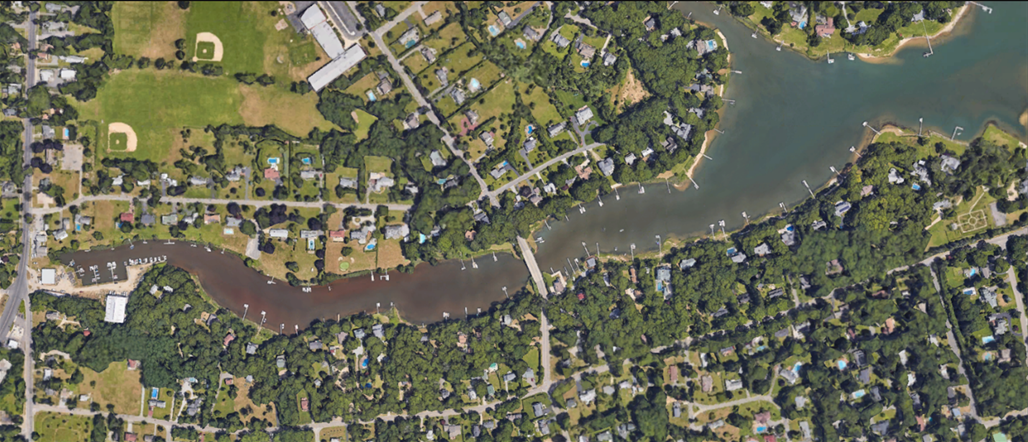
Alexandrium catenella bloom in Jockey Creek, New York, 2024. Credit: Chris Gobler.
During a harmful algal bloom, shellfish can accumulate dangerous concentrations of toxins in their tissues. These toxins cannot be destroyed by freezing or cooking shellfish. Shellfish are regularly monitored for algal toxins, and harvests are closed when toxins exceed regulatory limits.
This NCCOS-supported HAB Event Response project will provide expanded sampling coverage of HAB cells and toxins to assess the extent of the Alexandrium bloom, providing state managers with timely information to help protect human health. The team will also collect bloom water samples for genetic analysis. These samples will provide valuable insight into the dynamics and ecology of these HAB events, and could help researchers identify signs that could be used for early warning for future HAB events.
In previous years, blooms of Alexandrium have sometimes been followed by blooms of Dinophysis. The response team plans to continue sampling through the end of the Alexandrium blooms in case they transition to Dinophysis blooms, providing critical information for state shellfish management and public health, and improving scientific understanding of HAB dynamics.
PSP is caused by neurotoxins (like saxitoxin) produced by certain species of harmful algae, including Alexandrium catenella. Another harmful algae, Dinophysis, is associated with diarrhetic shellfish poisoning (DSP). Symptoms of DSP in humans can include nausea, vomiting, and diarrhea, while symptoms of PSP in humans may additionally include numbness or tingling of the mouth and lips, and cardiac and respiratory failure.
For more information, visit the NCCOS Harmful Algal Bloom Event Response Program webpage.
Sampling is underway as the University of Washington Tacoma, Washington Department of Health, and the Washington Department of Fish and Wildlife work to map overwintering harmful algal cysts in Willapa Bay and Grays Harbor, Washington in partnership with NOAA’s National Centers for Coastal Ocean Science (NCCOS) Harmful Algal Bloom (HAB) Event Response Program. The resulting cyst map data will help state shellfish managers and growers predict potential blooms this spring and summer, and mitigate their harmful impacts on the region.
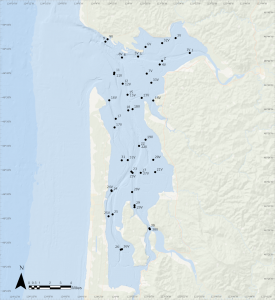
Map of Willapa Bay survey stations for the Alexandrium catenella cyst survey completed in January 2025 by the University of Washington Tacoma, Washington Department of Health, and Washington Department of Fish and Wildlife in partnership with NOAA NCCOS’ HAB Event Response Program. Credit: Cheryl Greengrove.
In May and June of 2024, Washington and Oregon experienced an extreme paralytic shellfish poisoning (PSP) event along their coastal beaches and bays, prompting response assistance from NCCOS. This PSP event marks the first documented outbreak causing widespread shellfish closures along Washington and Oregon’s coasts since the 1990s. Over 40 individuals in Oregon were confirmed to have PSP, some requiring hospitalization. Recreational and commercial shellfisheries in both states had to be closed due to high levels of PSP toxins, including in Washington’s Grays Harbor and Willapa Bay. In Willapa Bay, emergency shellfish recalls and closures led to over $900,000 in losses for the commercial shellfish industry, leading to additional hardships for rural Washington communities.
PSP is caused by neurotoxins (like saxitoxin) produced by certain species of harmful algae, including Alexandrium catenella. During an Alexandrium bloom, shellfish can accumulate dangerous concentrations of PSP toxins in their tissues. These PSP toxins can not be destroyed by freezing or cooking shellfish. Consuming toxic shellfish can cause PSP in humans and other animals, including marine mammals and birds. Symptoms of PSP in humans can include numbness or tingling of the mouth and lips, nausea, vomiting, diarrhea, cardiac and respiratory failure. Shellfish are regularly monitored for HAB toxins, and harvests are closed when toxins exceed regulatory limits.
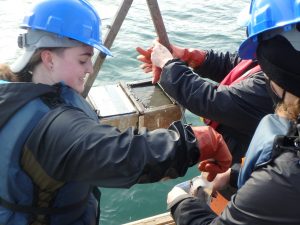
Van veen grab sampling of surface sediments for NOAA MERHAB Alexandrium catenella cyst survey in Puget Sound January 2022 aboard the UW APL R/V Robertson by University of Washington Tacoma researchers (Caitlyn McFarland, Julie Masura and MaggieJo Baer). Photo credit: Cheryl Greengrove.
Alexandrium forms dormant cysts that overwinter on the seafloor. If conditions are right the following summer, the cysts (like seeds) germinate, swim to the surface and multiply, potentially forming another bloom. Maps of cyst abundance combined with other contextual data can help inform our understanding of where future toxic Alexandrium blooms and PSP outbreaks could occur.
This NCCOS-supported HAB Event Response project will provide the first Alexandrium cyst maps of southern Washington’s Willapa Bay and Grays Harbor, providing critical information for contingency planning for state agencies and shellfish growers.
For more information, visit the NCCOS Harmful Algal Bloom Event Response Program webpage.
Floating Sargassum seaweed in the Caribbean provides habitat and nurseries for a variety of marine life. However, in recent years, the region has seen a dramatic increase in the extent and frequency of this brown macroalgae that ultimately washes ashore, often with devastating impacts for coastal economies and ecosystems.
To better understand residents’ perceptions of this phenomenon, NCCOS-funded researchers surveyed community members about Sargassum event incidence, impacts, and management. In total, 633 individuals participated in the survey, representing 39 national, provincial, and territorial governments across the Caribbean.

Removing Sargassum from Great Bay Beach in St. Thomas, U.S. Virgin Islands. Credit: Tia Rabsatt, Virgin Islands Department of Planning and Natural Resources – Division of Fish and Wildlife.
Sargassum’s impact on tourism and recreation was the paramount concern of study respondents. Smelly and unsightly Sargassum on beaches drives tourists away, and excess Sargassum in the water restricts leisure activities such as swimming, snorkeling, and fishing. Adding to the lost revenue from lost tourism, cleanup and disposal costs are also considerable. In Quintana Roo, Mexico, for example, Sargassum cleanup efforts are estimated to cost as much as $1.1 million per kilometer per year.
Public health concerns also figured prominently among survey respondents. Decomposing Sargassum emits hydrogen sulfide and ammonia that, at high levels, can cause negative health outcomes. One study found that people exposed to Sargassum for at least a week exhibited adverse respiratory, dermatological, and neurological symptoms.
Historically, the majority of Sargassum was located in the Sargasso Sea in the western North Atlantic. However, in 2011, the geographic range of Sargassum expanded to include what is now known as the “Great Atlantic Sargassum Belt,” a Sargassum-rich area that stretches from West Africa to the Gulf of Mexico. The belt is thought to be fueled by an increase in the availability of land-based nutrients, particularly nitrogen, along with warming waters. Survey respondents perceived Sargassum events to be most severe, frequent, and disastrous in the western, central, and eastern parts of the Caribbean, along the main path of the belt.
In general, survey respondents had negative views of current Sargassum policies and management efforts, especially in the western, central, and eastern Caribbean. Survey findings can give local governments a regional baseline for the social impacts of Sargassum and can offer insights into which communities are most affected and which mitigation strategies might work best.
For more information, visit the NCCOS Harmful Algal Bloom Event Response Program webpage.
Recent reports from the Washington State Department of Fish and Wildlife indicate that harmful algal bloom (HAB) activity is picking up along the outer WA coast, with a plankton species known as Pseudo-nitzschia (PN) and its associated toxin, domoic acid (DA), being detected at elevated levels across several water quality monitoring sites. As a result, NCCOS Hollings Marine Laboratory scientists from Charleston, SC have traveled to the Northwest Fisheries Science Center (NWFSC) in Seattle to work with NWFSC scientists to calibrate a DA toxin sensor prior to its deployment on an Environmental Sample Processor (ESP; aka ‘ESPeddie’), a robotic self-contained device. The scientists will deploy the NCCOS DA sensor onboard the NWFSC’s ESPeddie at a routinely monitored site approximately 15 miles off La Push, WA. The NWFSC has been deploying ESPS with the DA toxin sensor onboard once or twice a year since 2015.
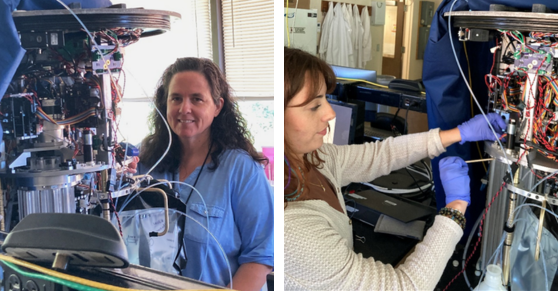
Left: NCCOS scientists Tina Mikulski calibrating the NCCOS domoic acid toxin sensor on Environmental Sample Processor ‘ESPeddie’, in preparation for deployment off the WA coast. Right: NCCOS Scientist Rayanne Scarmeas calibrating the DA sensor.
The mission for this uncrewed ESP platform, also referred to as a ‘lab-in-a-can’, will begin in late July and is scheduled to run through late October. During this time, the NCCOS DA sensor onboard the NWFSC’s ESPeddie will measure “particulate” DA (pDA) levels in these offshore waters, an area that can serve as an incubator for toxic PN blooms. These blooms are capable of contaminating razor clams, a popular and important food source, along the coast. Toxin measurements are transmitted to shore in near real-time where NCCOS scientists process the data. The pDA values are uploaded to the NANOOS Real-time HABs website, and also inform the PNW HAB Bulletin, both of which are accessed by state and tribal shellfish managers, as well as public health officials, to support critical decisions on commercial, recreational, and subsistence harvest closures.
Support for this effort is provided in part by NCCOS MERHAB and IOOS OTT awards, both led by the University of Washington.
For more information, visit the NCCOS Harmful Algal Bloom Event Response Program webpage.
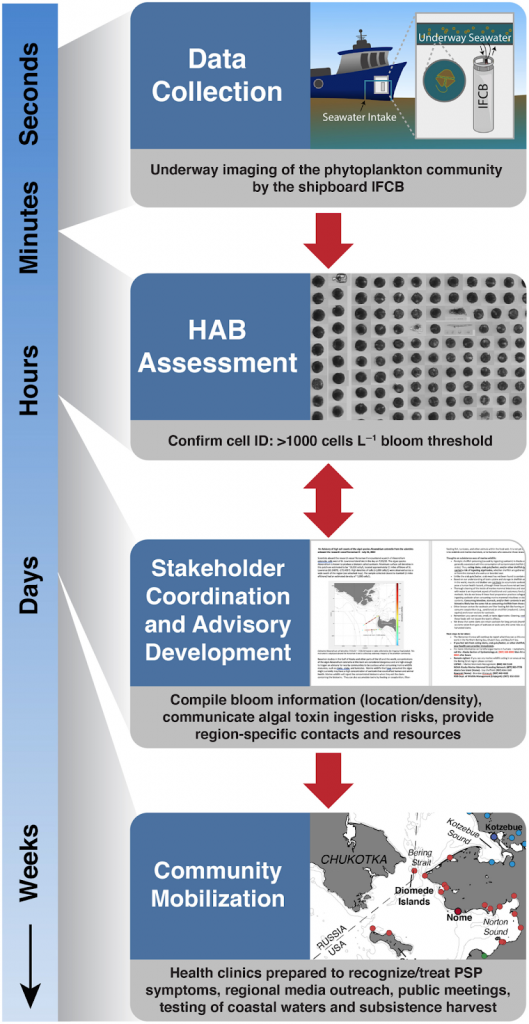
Timeline and structure of rapid detection and risk communication information flow from shipboard HAB detection using an Imaging FlowCytobot (IFCB) to the regional coastal response (Fachon et al. 2024 Limnology and Oceanography Letters).
During summer 2022, a research cruise detected a massive bloom of the harmful algae, Alexandrium catenella, that spread at least 600 kilometers (~370 miles) from the northern Bering Sea to the southern Chukchi Sea. The new technologies used to track this harmful algal bloom (HAB) event and real-time collaborative communication with western Alaska entities to alert and inform remote coastal communities in the Bering Strait region are detailed in a new publication, “Tracking a large-scale and highly toxic Arctic algal bloom: rapid detection and risk communication,” in Limnology and Oceanography Letters.
Alexandrium catenella produces neurotoxins called paralytic shellfish toxins (PSTs). These toxins can accumulate in organisms that consume the algae, and the toxins can be transferred through the marine food web causing illness or mortality of marine animals and can cause Paralytic Shellfish Poisoning (PSP) in people who eat contaminated seafoods. During this 2022 HAB event, Alexandrium cell density exceeded 174,000 cells per liter – the highest Alexandrium cell density ever observed in Arctic waters. Cell densities exceeding 1,000 cells per liter are considered dangerous.
While commercial seafood products are monitored for HAB toxins to ensure consumer safety, coastal communities in western and northern Alaska often rely on subsistence seafoods that are not regularly tested. The authors hope this research will bring attention to the issues the Bering Strait region is facing, and motivate more robust testing and monitoring. They note that continued warming may shift the Pacific Arctic towards more favorable conditions for Alexandrium catenella blooms, and that comprehensive monitoring and response resources will be essential in mitigating the impacts of future HAB events.
The collaborative communications between scientists and HAB-affected communities during the 2022 HAB event demonstrated that researchers and western and northern Alaskan coastal communities benefit by directly working together on emerging threats to marine wildlife resources and human health. To advance such capacity sharing, the NCCOS HAB Event Response Program awarded funding during summer 2023 for the collection of real-time HAB data in the Bering Strait region and proactive, region-specific HAB outreach and response planning to inform and prepare Bering Strait communities for HAB events.
This study was supported in part by the NCCOS Ecology & Oceanography of Harmful Algal Blooms (ECOHAB) project Trophic Transfer and Effects of HAB Toxins in Alaskan Marine Food Webs, led by Don Anderson at WHOI and Kathi Lefebvre at NOAA’s Northwest Fisheries Science Center (NWFSC).
ECOHAB is a peer-reviewed, national, competitive program that funds research to advance understanding of the causes and impacts of HABs. ECOHAB research informs management of coastal resources to reduce HAB impacts and future threats.
Related news:
- WHOI Press Release: The Detection of a Massive Harmful Algal Bloom in the Arctic Prompts Real-Time Advisories to Western Alaskan Communities
- Collaborative Efforts Lead to Proactive Harmful Algal Bloom Risk Advisories in Alaska’s Bering Strait Region
- Warming oceans are pushing harmful algal blooms into polar waters
For more information, visit the NCCOS Harmful Algal Bloom Event Response Program webpage.
NOAA’s National Centers for Coastal Ocean Science (NCCOS) Harmful Algal Bloom (HAB) Event Response Program awarded $6,000 to the University of Washington’s Olympic Natural Resources Center, Northwest Indian College, and Oregon Department of Fish and Wildlife to assist with Oregon’s response to an outbreak of Paralytic Shellfish Poisoning (PSP). Since Memorial Day weekend, at least thirty-one people have become ill after eating shellfish harvested from the northern coast of Oregon, with some people requiring hospitalization. Shellfish testing results indicated PSP as the cause of these illnesses, prompting Oregon to issue harvesting closures for mussels, razor clams, bay clams, and oysters.
PSP is caused by neurotoxins (like saxitoxin) produced by certain species of harmful algae, including Alexandrium catenella. During an Alexandrium HAB event, shellfish can accumulate dangerous concentrations of PSP toxins. These PSP toxins are not destroyed by freezing or cooking shellfish. Consuming toxic shellfish can cause PSP in humans and other mammals, including marine mammals and birds. Symptoms of PSP in humans can include numbness or tingling of the mouth and lips, nausea, vomiting, diarrhea, cardiac and respiratory failure.
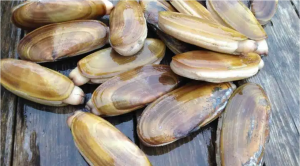
Razor clams are an economically important shellfish harvest off the coasts of Oregon and Washington. Closures of this shellfishery can result in millions of dollars of lost revenue. Credit: ConwaySuz via Flickr/Creative Commons.
Shellfish are regularly monitored for HAB toxins, and harvests are closed when toxins exceed regulatory limits. On May 23, Oregon initially closed all mussel harvesting from Seal Rock to Cape Lookout due to elevated PSP toxins in shellfish.
The state has since expanded the closure coastwide to include all harvest of mussels, commercial and recreational harvest of razor and bay clams, and commercial oyster sales in Tillamook, Netarts, and Umpqua Bays. In parts of Washington state, PSP toxin concentrations have also exceeded regulatory limits. As of June 5, Washington closed all recreational shellfish harvest statewide and paused commercial harvest in Willapa Bay. Both Oregon and Washington have issued recalls on some shellfish products due to this PSP event. It may be weeks to months after the bloom ends before shellfish harvest areas can be safely reopened and as the bloom can be patchy along the coast certain areas may open sooner than others. In both states, seafood companies and their workers are facing economic hardship and state labs are working to handle the increase in regulatory sample testing.
This NCCOS-funded HAB Event Response project seeks to aid both industry and state agencies. Rapid tests to pre-screen shellfish samples for PSP toxins, like the enzyme-linked immunosorbent assay (ELISA) could reduce the number of samples analyzed by state health departments, helping meet the immediate need for better early warning of rising PSP toxin concentrations in seawater and shellfish. The NCCOS-funded response team will work with the Olympic Region HAB (ORHAB) partnership and partners at Oregon State University to obtain shellfish and seawater samples from Oregon and Washington beaches. The team is working with Beacon Analytical Systems to develop an ELISA as a rapid test for analyzing shellfish and seawater samples, to help reduce the chance of additional PSP illnesses. Results from the ELISA will be confirmed by the Northwest Indian College Salish Sea Research Center using another toxin detection method, liquid chromatography mass spectrometry (LCMS). This approach promises to provide rapid analytical tools that are key to safeguarding human health, especially when HABs appear with little warning.
NOAA continues to work with federal, state, and other partners to assist with the response to this ongoing HAB event. NCCOS scientists used satellite imagery to confirm for partners that a large phytoplankton bloom formed rapidly off the coast of Oregon over Memorial Day weekend. NOAA and U.S. Integrated Ocean Observing System (IOOS)-funded researchers are also helping document the offshore extent of the bloom.
Before harvesting shellfish, call the biotoxin hotline in your state for the most up-to-date information on closures.
Oregon shellfish biotoxin hotline: (800) 448-2474.
Washington biotoxin/red tide hotline: (800) 562-5632.
The NCCOS HAB Event Response Program provides immediate support to help state, tribal, and local officials manage events and advance the understanding of HABs as they occur. For more information about the NCCOS HAB Event Response Program, contact us at nccos.hab.event.response@noaa.gov.
Partner Links:
- University of Washington – Olympic Natural Resources Center
- Northwest Indian College – Salish Sea Research Center
- Oregon Department of Fish and Wildlife (ODFW)
- Olympic Region Harmful Algal Bloom (ORHAB) Partnership
- Oregon State University
- Beacon Analytical Systems
Related Links:
- Oregon Department of Agriculture – Recreational Shellfish Biotoxin Closures
- Washington Department of Health – Shellfish Safety Information
For more information, visit the NCCOS Harmful Algal Bloom Event Response Program webpage.
The Florida Fish and Wildlife Conservation Commission (FWC) has received nearly 500 reports of unusual fish behavior from the Lower Florida Keys since last November, with over 52 species of fish affected, including endangered smalltooth sawfish. Affected fishes swim in circles at the water’s surface and lose their ability to stay upright when exposed to bright light at night. While the cause of the fish behavior remains unknown, initial water samples collected where fish exhibited these behaviors indicated high concentrations of benthic harmful algae. Unlike Florida red tide, which is caused by a type of harmful algae that is usually found at the water’s surface, benthic harmful algae are associated with, or occur on, the bottom of a body of water, where benthic species like sawfish live and feed.
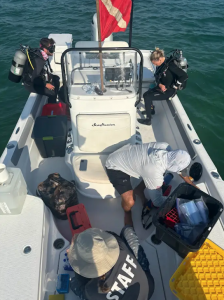
Florida Gulf Coast University students, Nick Frankenburger and Kenzie Pruitt getting ready to dive while staff, Adam Catasus and Rachael Schinbeckler, prepare samples. (Credit: Andrew Tipler)
NOAA’s National Centers for Coastal and Ocean Science (NCCOS) Harmful Algal Bloom (HAB) Event Response Program awarded $25,000 to Florida Gulf Coast University, Bonefish & Tarpon Trust (BTT), and the University of South Alabama to investigate the high concentrations of benthic harmful algae and potential links to the unusual fish behavior being observed in the Lower Florida Keys. Staff from BTT, the Lower Keys Guides Association, and Everglades National Park are acting as researchers’ “eyes on the water,” using methods developed during previous studies to collect samples to help detect benthic harmful algae. One aim of the research is to determine the spatial extent of the elevated concentrations of benthic harmful algae in the region. The team is collecting samples of seagrasses and benthic macroalgae to identify and quantify any associated harmful algae or harmful algae toxins. They will also test tissue samples collected from fish exhibiting abnormal behavior for harmful algae toxins.
The research team’s work is part of a wide, collaborative response to this ongoing event affecting fish in the Florida Keys. Scientists from NCCOS’ Phytoplankton Monitoring Network also identified elevated concentrations of benthic harmful algae in water and seaweed samples from the Florida Keys, corroborating the HAB research team’s initial findings. These samples were collected and sent by Florida Atlantic University researchers. Additionally, NOAA Fisheries and FWC are coordinating an emergency response effort specific to the endangered sawfish impacted by this event. Personnel from the HAB and sawfish response efforts are collaborating to share information and ideas as they continue to investigate the cause of the unusual fish behavior in the region.
The NCCOS HAB Event Response Program provides immediate support to help state, tribal, and local officials manage events and advance the understanding of HABs as they occur. For more information about the NCCOS HAB Event Response Program, contact us at nccos.hab.event.response@noaa.gov.
To report a related fish kill, diseased fish, fish with other abnormalities, or discolored water, contact the Florida Fish and Wildlife Conservation Commission’s (FWC) Fish Kill Hotline: (800) 636-0511. If you see a sawfish in distress, call the Sawfish Hotline at 844-4-SAWFISH (844-472-9347) or email sawfish@myfwc.com.
Partner Links:
- Florida Gulf Coast University
- Bonefish & Tarpon Trust
- University of South Alabama
- Lower Keys Guides Association
- Everglades National Park
- Florida Fish and Wildlife Conservation Commission (FWC)
- Florida Atlantic University
Related Links:
- NOAA NCCOS Response and Readiness for HAB Events
- NOAA Fisheries Emergency Response Effort for Endangered Sawfish
- FWC: Florida Keys Abnormal Fish Behavior Event 2023 – Present
For more information, visit the NCCOS Harmful Algal Bloom Event Response Program webpage.
In April 2022, an experiment was conducted at the Mote Marine Lab Florida Red Tide Mitigation and Technology Development Initiative indoor mesocosm facility in Sarasota, FL to determine the effectiveness of using clay as a possible treatment for reducing the effects of harmful algal blooms (HABs) in Florida. The results from this experiment, published in Harmful Algae, found that clays are an effective method to reduce the effects of HABs on our marine ecosystems. HABs regularly disrupt ecological processes and local economies along the coasts of the Gulf of Mexico. HABs occur almost annually on the west coast of Florida, persisting for weeks, months, or even years. In addition to inducing cloudy and low-oxygen conditions, HABs can also produce neurotoxins, which directly or indirectly affect every level of the marine food web, inflicting mass mortalities in fish and other marine animals. In Florida, each bloom event can result in the loss of millions of dollars to the local economy.

Scientist Mike Henry of the Mote Marine Laboratory sprays clay slurries into Florida’s Sarasota Bay. Credit: Jim Culter/Mote Marine Laboratory
Bloom control strategies can be used alongside other management techniques, such as nutrient reduction and long-term monitoring, to reduce the damaging effects of HABs. Clay-based “flocculants” (a substance that makes fine particles clump, or aggregate, together) are used globally as a method of controlling harmful algal blooms, and their use is currently under consideration to control Karenia brevis blooms in Florida.
Using the mesocosm tanks, researchers evaluated the chemical dynamics and lethal and sublethal impacts of the clay over 72 hours on a benthic community representative of Sarasota Bay, which included blue crab, sea urchin, and hard clam. The application of clay successfully removed K. brevis cells but was less effective at toxin removal than expected. The clay also removed dissolved and particulate phosphorus from the water column, and significantly reduced pH and alkalinity over the 72-hour observation period. The lethal and sublethal responses to clay-treated K. brevis did not differ from untreated K. brevis for either of the three species at any time point, suggesting clay treatment at this dosage has negligible impacts to these species within 72 h of exposure.
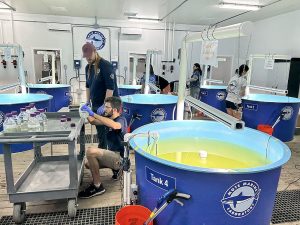
Woods Hole Oceanographic Institute and Mote Marine Laboratory test the impact of modified clay with algaecides on Karenia brevis, water quality and keystone marine species from the Gulf of Mexico, including crabs, sea urchins and clams. Credit: Mote Marine Laboratory. (Photo: Mote Marine Laboratory)
In concept, clay particles aggregate with algal cells, quickly and efficiently removing the majority of bloom biomass from the water column. Clays have also been shown to be effective at removing HAB toxins. Compared to alternative methods of bloom control, such as algicidal bacteria, clay is inexpensive, abundant, and thus far has shown minimal environmental impacts, which makes this method an attractive option for large-scale use. Extensive research has been conducted to develop formulations of clay that are harmless to non-target organisms at effective treatment concentrations. In several cases, clay treatment of HAB species has been shown to reduce mortality rates of co-occurring organisms compared to those exposed to untreated bloom conditions.
Scientists from the University of Central Florida, Mote Marine Laboratory, Woods Hole Oceanographic Institute, and the University of Rhode Island carried out this experiment and conducted analyses. This work is part of a joint effort between NCCOS and Mote Marine Lab that is leveraging funds from the Prevention, Control, and Mitigation of Harmful Algal Blooms Program and Florida Red Tide Initiative to develop and test the effectiveness of HAB control methodologies.
For more information, visit the NCCOS Harmful Algal Bloom Event Response Program webpage.
NCCOS scientists and partners are now exploring a controlled-release method for managing harmful algal blooms (HABs). Controlled-release technologies allow for a product to be delivered at a predictable and consistent rate to achieve an optimal dosage or application rate over time. While controlled-release technologies are commonly used for pharmaceuticals, applying this technique for environmental purposes is relatively new.
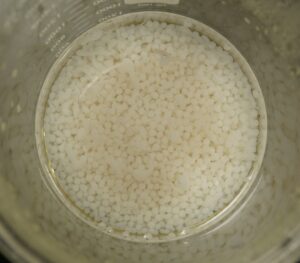
The team developed these medium-sized alginate beads, which are now used in the project.
A new study, “Development of alginate beads for precise environmental release applications: A design of experiment based approach and analysis,” in the Journal of Environmental Management, focuses on understanding how various factors influence the stability and diffusion of product from alginate-based, controlled-release technologies for future environmental applications of HAB control products. Alginate is a non-toxic substance extracted from brown algae and is widely used to encapsulate pharmaceuticals due to its ability to form porous gels that allow for the consistent release of product over a prolonged period of time. Alginate was ideal for this study due to its environmental safety, widespread availability, and relatively low-cost, which allows for its sustained use in natural waters at various scales. Through this study, scientists explored various factors and characteristics of the alginate beads to improve and fine tune the best controlled-release rate of the product. Factors considered included: chitosan molecular weight and concentration (protective coating that can help prolong the sustained release of product), calcium concentration (gelling agent that influences bead porosity), drop height (directly affects bead shape and overall stability), and bead size (impacts maximum amount of product encapsulated per bead). The team used Brilliant Blue Dye as a measurable surrogate tracer for encapsulated active products to show how these modifications to the alginate beads would change the rate of release into seawater over time. This approach enabled scientists to understand differences in predicted controlled-release application rates to marine waters for the first time.
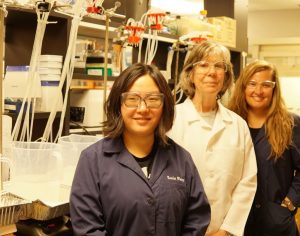
Scientists, (from left) Dr. Yanfei Wang (UD), Dr. Kathy Coyne (UD), and Dr. Kaytee Pokrzywinski (NCCOS) gather at the University of Delaware (UD) Hugh R. Sharp Campus, Lewes, DE to test the methodology of the alginate beads in in situ mesocosms in the Broadkill River, Lewes, DE. The scaled-up prototype bead production equipment can be seen in the background, including customized, 3D printed tubing spacer.
The study indicated that a combination of both large and small beads may be the most successful strategy to maximize effectiveness in controlling HABs in marine waters in the future. For example, small beads have a faster release rate that would provide an immediate treatment of HABs, while large beads with more product contained within would provide sustained, prolonged treatment to limit risks around potentially recurring HAB events.
In addition to the management of HABs, this approach could aid in addressing a variety of challenges throughout the environmental and healthcare realms.
Read the full journal article for more information. This research is part of a larger effort to control harmful algal blooms.
Partners in this effort:
- Bennett Aerospace
- U.S. Army Engineer Research and Development Center
- Virginia Polytechnic Institute and State University
- Oak Ridge Institute for Science and Education
- University of Delaware (UD) College of Earth Ocean, and Environment
For more information, visit the NCCOS Harmful Algal Bloom Event Response Program webpage.
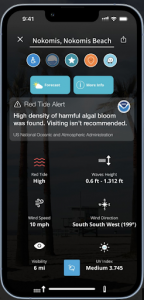
Example of the Beaches App, which includes information about current red tide conditions at beaches with NCCOS HAB Forecasts.
The Florida red tide respiratory irritation forecast is now being delivered through the Beaches App, a third-party app developed by Beaches App. Inc. The app incorporates information about beach conditions around the world, including in southwest Florida. Real-time forecast output is provided on the NCCOS HAB Forecasting website, where anyone, including the Beaches app developers, can ingest and use the forecast data which is updated every three hours. By incorporating information on the location and risk of respiratory irritation due to red tide, the Beaches App now allows beach goers to quickly identify beaches with low risk of respiratory irritation during a red tide event in southwest Florida.
In the Gulf of Mexico, some harmful algal blooms are caused by the microscopic algae species Karenia brevis, commonly called red tide. Karenia brevis blooms can cause respiratory illness and eye irritation in humans. It can also kill marine life, and lead to shellfish closures. Blooms are often patchy, so impacts vary by beach and throughout the day. NCCOS monitors conditions daily and issues regular forecasts for red tide blooms in the Gulf of Mexico and East Coast of Florida.
The example to the right shows the output from a beach with a high risk of respiratory irritation forecasted by NOAA’s red tide respiratory irritation forecast.
For more information, visit the NCCOS Harmful Algal Bloom Event Response Program webpage.
One year after a record-breaking, toxic algal bloom of Alexandrium catenella in the Bering Strait region of Alaska, highly collaborative efforts led by Norton Sound Health Corporation (NSHC), Alaska Sea Grant, and Woods Hole Oceanographic Institution (WHOI) to set-up a proactive harmful algal bloom (HAB) communication plan have been put to good use.
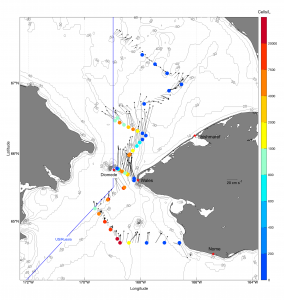
Map of Alexandrium catenella cell counts from July 28-29, 2023. Arrows indicate the direction of the ocean current at the time the seawater was sampled. (Credit: WHOI)
On July 28 and 29, WHOI researchers remotely monitoring for HAB species using an Imaging FlowCytobot (IFCB) aboard the R/V Sikuliaq detected dangerously high cell counts of Alexandrium in the Bering Strait region near St. Lawrence Island, Wales, and Little Diomede. Alexandrium catenella can produce saxitoxins – powerful neurotoxins that can cause potentially life-threatening Paralytic Shellfish Poisoning (PSP) in humans, seabirds, and marine mammals. It can also accumulate in subsistence resources like clams, crabs, tunicates, krill, algae-eating fishes, and organs of marine mammals and seabirds.
In accordance with a HAB communication plan developed before the bloom season, a HAB risk advisory on the consumption of marine wildlife resources was co-produced by WHOI, NSHC, Alaska Sea Grant, and NOAA, and sent out to the 20 tribal governments in the Bering Strait region, as well as regional health clinics, and local emergency planning committees. The HAB risk advisory was printed in the regional Nome Nugget newspaper, and translated into Russian and broadcast over regional radio to reach subsistence communities across the Bering Strait region. These outlets also featured news stories on the event with remarks from HAB event responders Gay Sheffield (Alaska Sea Grant) and Emma Pate (NSHC). Sheffield and Pate have spent much of the summer traveling to coastal communities throughout the Bering Strait region doing proactive HAB outreach to answer questions and provide information to help coastal communities make informed food safety decisions during HAB events.
The Bering Strait region does not have comprehensive HAB monitoring or HAB toxin testing for subsistence foods, so cooperative efforts like these are essential to reducing HAB-related risks. With the early warning provided by WHOI and the ship-deployed IFCB, and the communication efforts led by NSHC and Alaska Sea Grant, clinics were able to prepare to provide HAB-related information and care, and community HAB monitoring efforts were increased. Additionally, HAB sampling supplies and training were provided to personnel on Norton Sound Economic Development Corporation vessels that will provide additional HAB sampling via cruises of opportunity this fall.
This work was supported in part by two HAB Event Response awards (see here and here) from NOAA’s National Centers for Coastal and Ocean Science (NCCOS). The NCCOS HAB Event Response Program provides immediate support to help state, tribal, and local officials manage events and advance the understanding of HABs as they occur.
Partner Links:
- Norton Sound Health Corporation
- UAF Alaska Sea Grant
- Woods Hole Oceanographic Institution – Brosnahan Lab
- R/V Sikuliaq (Twitter)
- Norton Sound Economic Development Corporation
For more information, visit the NCCOS Harmful Algal Bloom Event Response Program webpage.
NOAA’s National Centers for Coastal and Ocean Science (NCCOS) Harmful Algal Bloom (HAB) Event Response program awarded $12,550 to Southern California Coastal Water Research Project (SCCWRP), University of California- Santa Cruz, The Marine Mammal Center, Scripps Institution of Oceanography, and Southern California Coastal Ocean Observing System (SCCOOS). These funds will support research to investigate the potential links between ongoing marine mammal strandings occurring off of Southern California and a suspected offshore Pseudo-nitzschia bloom.
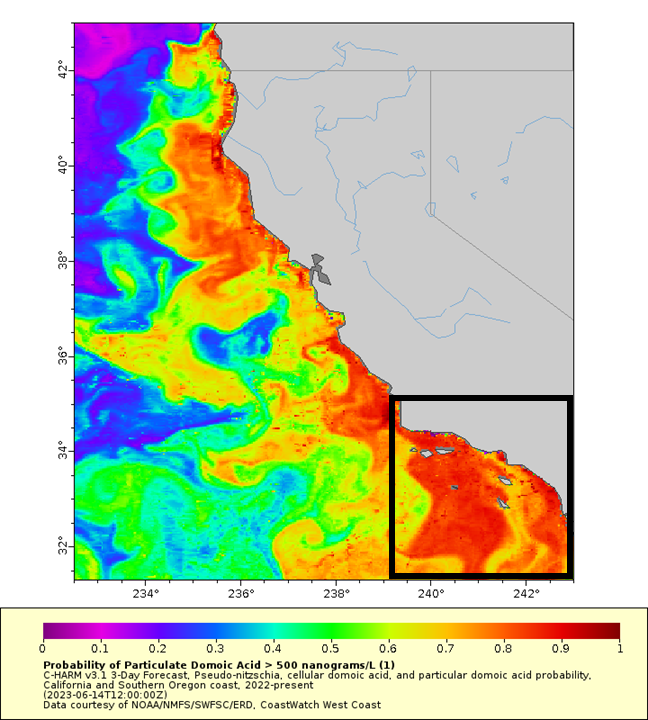
Predicted probability of domoic acid toxin levels from Pseudo-nitzschia off of southern California for June 14, 2023 from California-Harmful Algae Risk Mapping (C-HARM). The black box shows the region where a large number of stranded marine mammals were encountered throughout June, 2023. The waters along this region, particularly offshore, showed very high probabilities of particulate DA levels exceeding 500 ng/L. (Credit: CoastWatch West Coast)
Blooms of the harmful algae Pseudo-nitzschia can produce domoic acid (DA), a neurotoxin. DA can accumulate in small fish and shellfish and can lead to severe illness or death in marine mammals and seabirds that feed on those animals. Previous blooms of Pseudo-nitzschia in Southern California have been associated with DA intoxication, strandings, and deaths of marine mammals.
Last month, the West Coast Marine Mammal Stranding Network, coordinated by NOAA Fisheries, received hundreds of calls daily about sick and injured dolphins and California sea lions. Stranded sea lions exhibited symptoms of DA intoxication consistent with previous Pseudo-nitzschia bloom events; symptoms of DA intoxication can include head bobbing, swaying, foaming at the mouth, bulging eyes, paralysis, involuntary muscle spasms, and seizures. One of the primary goals of the current research is to determine DA levels in marine wildlife, including marine mammals experiencing severe symptoms from potential DA exposure and prey items that may be transferring DA to those animals.
Marine wildlife toxin data from this event response project can also benefit efforts to forecast Pseudo-nitzschia blooms in the region through the California Harmful Algae Risk Mapping (C-HARM) system. Earlier this summer C-HARM predicted elevated DA for the region, when many of the marine mammal strandings were first reported.
Another major goal of the project is to collect offshore water samples to characterize DA concentrations, to complement ongoing pier-based monitoring efforts. In Southern California, the SCCOOS Harmful Algal Bloom Monitoring and Alert Program (HABMAP) performs weekly pier monitoring for Pseudo-nitzschia and other HABs. This project will expand water sampling in offshore areas, providing critical data to understand the presence and toxicity of Pseudo-nitzschia.
This project builds off of efforts initiated last fall to investigate unusual marine mammal strandings in Southern California and links to a suspected offshore Pseudo-nitzschia bloom at that time. Interestingly, marine mammal strandings this year and last have not coincided with high numbers of Pseudo-nitzschia cells in nearshore samples, suggesting possible offshore blooms.
NCCOS-supported HAB Event Response researchers are collaborating with the Santa Barbara Channelkeeper, Los Angeles Waterkeeper, and the Aquarium of the Pacific to collect offshore water samples on cruises of opportunity. This award will provide these collaborators with HAB sampling kits and training to expand HAB sampling capacity.
The NCCOS HAB Event Response Program provides immediate support to help state, tribal, and local officials manage events and advance the understanding of HABs as they occur.
Stranded sea lions, dolphins, and other marine mammals can be reported to the West Coast Region Stranding Hotline: (866) 767-6114. For stranded live animals in Ventura and Santa Barbara Counties, residents should call Channel Islands Marine & Wildlife Institute’s Rescue Hotline at (805) 567-1505. For dead whales and dolphins in those counties, people should call Channel Island Cetacean Research Unit at (805) 500-6220.
Partner Links:
- Southern California Coastal Water Research Project (SCCWRP)
- Southern California Coastal Ocean Observing System (SCCOOS)
- Scripps Institution of Oceanography
- The Marine Mammal Center
- Biological and Satellite Oceanography Lab, UCSC
- Aquarium of the Pacific
- Los Angeles Waterkeeper
- Santa Barbara Channelkeeper
- West Coast Marine Mammal Stranding Network
- CoastWatch West Coast
For more information, visit the NCCOS Harmful Algal Bloom Event Response Program webpage.
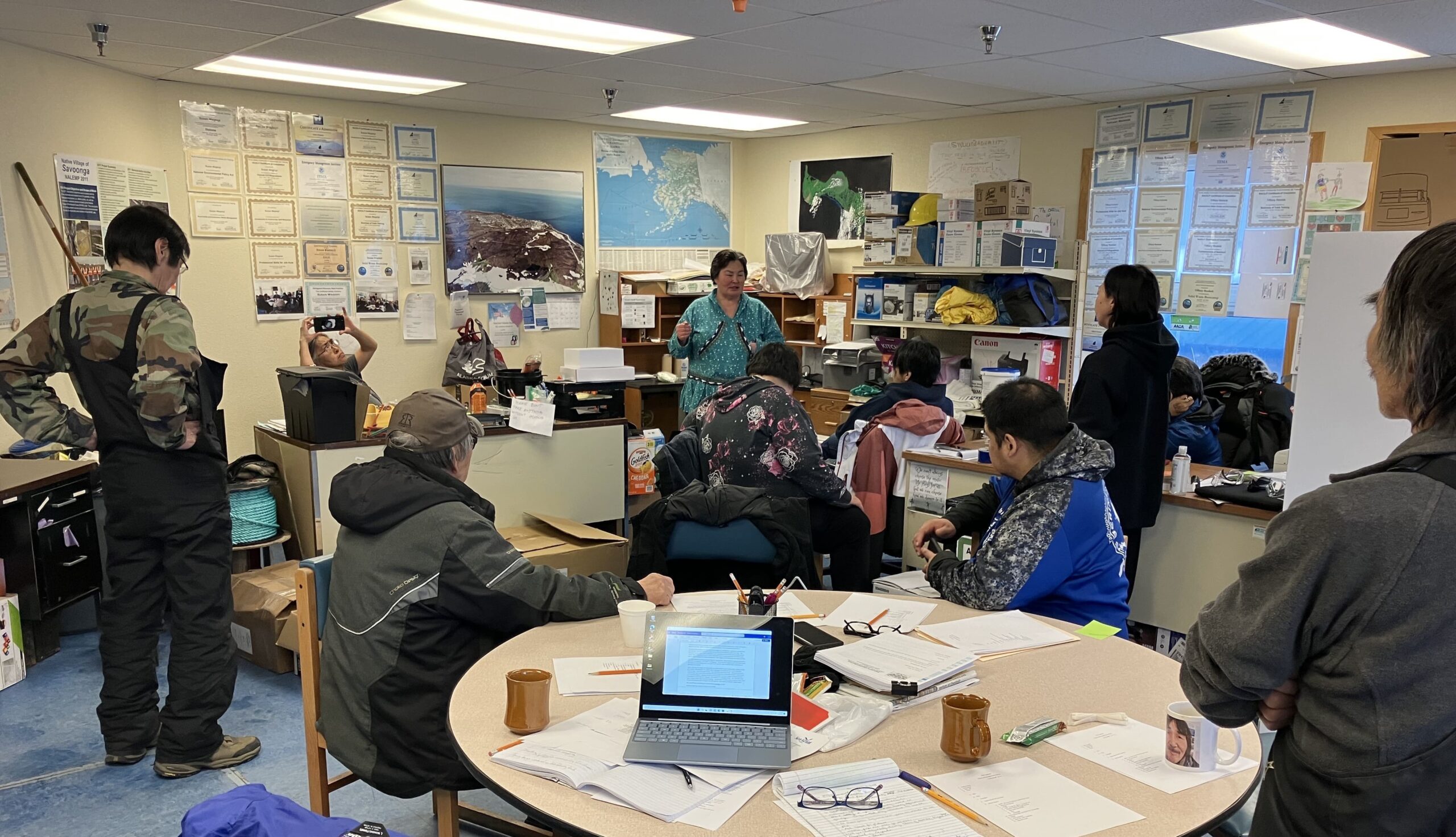
Emma Pate, Environmental Coordinator for the Norton Sound Health Corporation (center), provides information and answers questions about harmful algae at a 2022 HAB event at the Native Village of Savoonga Tribal Office on Saint Lawrence Island in the Bering Strait region. (Credit: G. Sheffield, UAF Alaska Sea Grant)
NOAA’s National Centers for Coastal and Ocean Science (NCCOS) Harmful Algal Bloom (HAB) Event Response program awarded $15,000 to Alaska Sea Grant and the Norton Sound Health Corporation. Throughout coastal communities of western and northern Alaska, the comprehensive ecosystem-wide use of the marine environment is essential to both food security and the nutritional, cultural, and economic well-being of regional residents. However, Alaska’s vast coastline prevents comprehensive HAB monitoring. This award supports proactive communication efforts to inform Bering Strait communities of subsistence food safety risks related to HABs.
During the summer of 2022, researchers at sea documented a massive offshore bloom of Alexandrium catenella in the Northern Bering Sea, Bering Strait, and southern Chukchi Sea (Kotzebue Sound region) of western and northern Alaska using a shipboard Imaging FlowCytobot (IFCB). A bloom of this magnitude is unprecedented in this region and the nation. The IFCB detected A. catenella cell concentrations well above levels known to cause dangerous shellfish toxicity in southeastern Alaska and in other regions globally. Risk advisories were sent to health authorities and the regional communication hubs of Nome and Kotzebue to alert coastal communities to the novel human health, wildlife health, and food security risks related to a HAB event of this scale. This summer, researchers will again use an IFCB to detect the offshore presence of toxic algal species in real-time to provide risk advisories to at-risk coastal communities.
Funding from this award will support radio and print communications about HAB risks and alert regional communities in the case of a HAB event. A series of in-person, community education forums throughout the Bering Strait region will ensure concerned individuals and families are equipped to make informed food safety decisions. This proactive outreach to remote Bering Strait communities will bolster regional HAB response efforts by preparing at-risk communities for a HAB event during summer 2023.
The NCCOS HAB Event Response Program provides immediate support to help state, tribal, and local officials manage events and advance the understanding of HABs as they occur.
For more information about the NCCOS HAB Event Response Program, contact sarah.pease@noaa.gov.
Partner Links:

Images captured by the Imaging FlowCytobot (IFCB) aboard the Norseman II off northwestern Alaska on August 21, 2022. Most of the images are of cells of Alexandrium catenella, a HAB species that can produce toxins. Credit: Brosnahan lab at WHOI
NOAA’s National Centers for Coastal and Ocean Science (NCCOS) Harmful Algal Bloom (HAB) Event Response program awarded $29,900 to the Woods Hole Oceanographic Institution (WHOI). Continuing a partnership formed last year between NCCOS-funded HAB researchers and regional leaders that revealed the largest and most toxic bloom of Alexandrium catenella ever recorded in the US, this award will support the collection of real-time HAB data in the Bering Strait region of Alaska this summer. If dangerous algal species are detected, this information will be shared with at-risk coastal communities via HAB risk advisories.
Alexandrium catenella produces paralytic shellfish toxins, a potent class of neurotoxins that can harm humans, marine mammals, and other wildlife. Blooms of the HAB species A. catenella can initiate in Alaskan waters from cysts that have settled onto the sea floor during previous years, or they can be transported from waters south of the Bering Strait.
In summer 2022, a shipboard Imaging FlowCytobot (IFCB) allowed researchers to capture real-time cell concentrations of A. catenella as the ship passed through blooms. In August 2022, cell concentrations reached over 150,000 cells/L, several orders of magnitude higher than cell concentrations known to cause dangerous shellfish toxicity. This prompted the researchers to issue risk advisories to Bering Strait communities and health authorities to alert individuals and families to food safety risks from consuming subsistence shellfish and other marine wildlife resources that may be contaminated with HAB toxins.
This funding will support the real-time IFCB detection of HAB species on four research cruises this summer in the Bering Strait region of Alaska. The IFCB will be aboard the R/V Sikuliaq for much of June through early October. WHOI scientists will remotely analyze data from the IFCB to identify HAB species and determine cell concentrations. Weekly updates will be distributed to appropriate stakeholders in the region, and if a dangerous HAB is detected, risk advisories will be issued to Bering Strait communities in coordination with Alaska Sea Grant, the Norton Sound Health Corporation, and others.
The NCCOS HAB Event Response Program provides immediate support to help state, tribal, and local officials manage events and advance the understanding of HABs as they occur.
For more information about the NCCOS HAB Event Response Program, contact sarah.pease@noaa.gov.
Partner Links:
NOAA’s National Centers for Coastal Ocean Science provided a harmful algal bloom (HAB) Event Response award of $4,520 to Scripps Institution of Oceanography, Southern California Coastal Ocean Observing System (SCCOOS), Southern California Coastal Water Research Project (SCCWRP), University of California- Santa Cruz, and The Marine Mammal Center. This award will fund their efforts to investigate the Pseudo-nitzschia bloom and co-occurrence of a marine mammal mortality event taking place off the coast of Southern California.
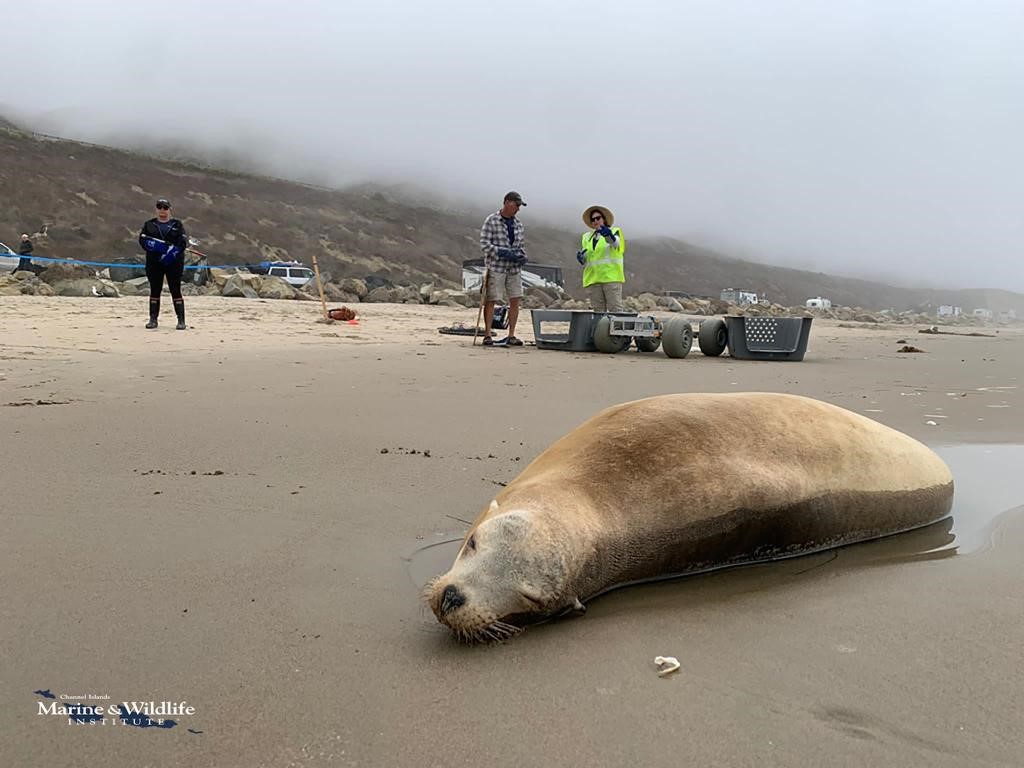
Channel Islands Marine & Wildlife Institute volunteers strategizing California Sea Lion rescue. (Credit: CIMWI)
Pseudo-nitzschia blooms result in the production of the neurotoxin domoic acid. On August 15, 2022, increased reports of California sea lions with signs of domoic acid intoxication from the Channel Islands Marine Wildlife Institute began appearing on social media and within the broader California marine mammal stranding network. Initially, the domoic acid intoxication cases were located in the Ventura area, southeast of Santa Barbara. Later that week, the first domoic acid intoxication case was reported in Santa Barbara County. By August 30, more than 60 California sea lions had been rescued, and ten deceased animals, including sea lions, northern fur seals, and dolphins, were recovered from beaches. Most of the deceased animals were adult female California sea lions and at least one was a northern fur seal that required euthanasia after treatment. In September, another ten California sea lions were rescued by centers farther south in Los Angeles and Orange Counties, along with one deceased dolphin. The stranded sea lions exhibited symptoms of domoic acid intoxication, consistent with previous Pseudo-nitzschia bloom events.
The California Harmful Algae Risk Mapping (C-HARM) System, which uses satellite imagery and circulation modeling to produce spatially explicit domoic acid forecasts, has produced forecasts that align with the present event, first predicting a highly localized patch of domoic acid risk in the Ventura, CA area that eventually spread into the Santa Barbara Channel and has recently intensified in a narrow coastal swath from Orange County to the Mexico border. However, SCCOOS-funded pier monitoring via the Harmful Algal Bloom Monitoring and Alert Program (HABMAP), which collects weekly phytoplankton and water quality data at ten locations along the California coast, has not captured indications of a significant bloom event.
Given the mismatch in coastal phytoplankton monitoring and ecosystem impacts during this event (ie. cell concentrations were not detected by pier monitoring despite marine mammal strandings on beaches with signs of DA intoxication), this award will support the offshore sampling of domoic acid concentrations in areas not routinely monitored in the Santa Barbara Channel. This sampling will be conducted aboard the Santa Barbara Channelkeeper cruises-of-opportunity. It is critical to sample the bloom as quickly as possible to better understand cross-shore variability and the nearshore/offshore decoupling of domoic acid production.
In addition, this award will support the determination of acute impacts to marine wildlife by funding analysis of the active toxin – domoic acid in animal tissues – to assist in keeping track of marine mammal impacts throughout the bloom event. Scientists at SCCOOS and SCCWRP will work directly with regional partners, including the California marine mammal stranding network, and local communities to communicate results from this emergency response.
For more information, visit the NCCOS Harmful Algal Bloom Event Response Program webpage.
NOAA’s National Centers for Coastal Ocean Science (NCCOS) provided a Harmful Algal Bloom (HAB) Event Response award of $15,420 to the U.S. Geological Survey- California Water Science Center (USGS-CAWSC) and San Francisco Estuary Institute (SFEI). This award will fund their efforts to investigate the extensive Heterosigma akashiwo bloom taking place in San Francisco Bay. The NCCOS Harmful Algal Bloom Monitoring System is also providing satellite images of the H. akashiwo blooms to determine development and extent.
First reports of discolored red or brown water occurred in mid-late July 2022 around Alameda Estuary. California Department of Public Health collected samples and was the first to confirm the organism as H. akashiwo. Scientists at the USGS- CAWSC and the SFEI were tracking the event using remote sensing products. In early August, evidence emerged that the bloom was expanding into the open-bay waters of South Bay San Francisco Bay. By the end of August, Sentinel-3 satellite imagery (provided by NOAA) and field observations found that the bloom had extended across the entire South Bay. At this same time, observations from the public of dead fish washing on shore began to be reported, with over 200 reports of fish mortalities distributed through the Bay. The dead fish were made up of a wide range of taxa, including sturgeon, striped bass, leopard sharks, bat rays, and numerous smaller species. There were concerns that fish impacts could eventually expand into the low-salinity zone of Suisun Bay as this region provides important habitat to the federally endangered Delta Smelt, and is an important stop-over habitat for migrating salmonids.
Around August 29 the bloom began to decline. Chlorophyll levels from field surveys on August 31 and September 1 were near ambient pre-bloom concentrations. Notably, dissolved oxygen concentrations had decreased in the South Bay (Oakland to San Jose), so the negative impacts of the bloom continued to persist even after the bloom had subsided. Oxygen levels eventually returned to pre-bloom concentrations in early September. This was the first low dissolved oxygen event to impact an entire sub embayment (South Bay) since monitoring began in the 1970s.
The cause of the massive die off is still unknown but may be attributed to toxins produced by H. akashiwo, or low dissolved oxygen concentrations as the high-biomass bloom dies and decomposes. To date, the mechanism of H. akashiwo toxicity is unknown although a number of potential mechanisms have been proposed. These mechanisms are difficult to study because they are complex and some toxic compounds may be ephemeral. The California Interagency HAB Illness workgroup has received two reports of human illness possibly related to the SF Bay marine HAB (H. akashiwo) event. Symptoms occurred following water contact, and the Illness workgroup is investigating the potential connection.
USGS and SFEI researchers are using NCCOS HAB Event Response funding to analyze water quality, genetic, and microscopy samples collected to measure and track the bloom development and expansion. These data will be compared with long term monitoring data to identify changing conditions that might have led to this large bloom.
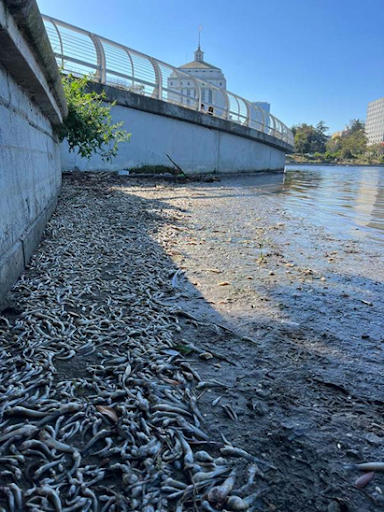
Fish kill in Lake Merritt (Oakland, CA) on August 27.
Additionally, NCCOS provided remotely sensed images of the bloom that the State Water Resources Control Board (CA Water Boards) used to track the spatial extent as it expanded across the San Francisco Bay. These images were published to expedite data sharing among responding agencies and organizations. The product was posted on the HAB Reports web page that centralizes information on incident reports and monitoring data from partner agencies including USGS. The remotely sensed information also helped prioritize outreach to local health agencies in the area of impact and support targeted incident response and beach advisories.
The NCCOS HAB Event Response Program provides immediate assistance to help federal, state, and local officials manage events and advance the understanding of HABs as they occur. The NCCOS Harmful Algal Bloom Monitoring System routinely delivers near real-time products for use in locating, monitoring and quantifying algal blooms in coastal and lake regions of the US.
For more information, visit the NCCOS Harmful Algal Bloom Event Response Program webpage.
NOAA’s National Centers for Coastal Ocean Science (NCCOS) provided a Harmful Algal Bloom (HAB) Event Response award of $6,820 to the Virginia Institute of Marine Science (VIMS) to respond to an intense HAB in the lower Chesapeake Bay, in collaboration with NOAA, Virginia Department of Health, and state shellfish growers. These efforts will also help improve regional HAB monitoring and forecasting capabilities by supporting satellite algorithm validation activities.
In mid-August, the formation of a very intense bloom of the toxin-producing algal species Margalefidinium (previously Cochlodinium) polykrikoides in the York River, VA was confirmed by satellite imagery and aerial photos. Since 2007, blooms of M. polykrikoides have historically been followed by large and extensive blooms of another HAB-forming species, Alexandrium monilatum, throughout the lower Chesapeake Bay. Both species are considered harmful because they have been known to cause adverse effects on juvenile oysters, finfish, and other commercially important seafood. Virginia ranks second in the nation for production of farmed oysters, and first in clam production. Therefore, these intense blooms cause great concern about ecological and economic impacts on valuable aquaculture and fishing industries throughout the Chesapeake Bay because they impact the health and growth of shellfish. However, they do not result in toxic shellfish and there have not been reported human illnesses associated with consumption of Chesapeake Bay shellfish.
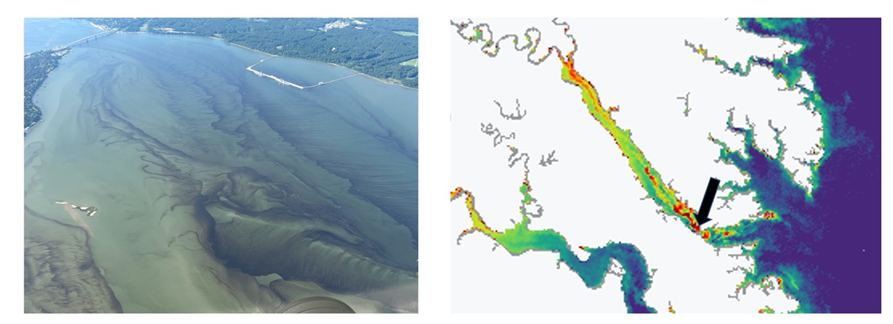
(Left) Aerial view of the Margalefidinium polykrikoides bloom August 9, 2022 in the York River, VA. Credit: Savannah Mapes, VIMS. (Right) Sentinel satellite image of the M. polykrikoides bloom on August 9, 2022. The black arrow indicates location of the aerial image shown on the left.
VIMS researchers are using this funding to collect water samples and quantify algal cells via FlowCam and quantitative PCR, while NOAA is collecting above-water radiometer measurements for satellite algorithm development for Sentinel-3 satellites and processing bulk chlorophyll levels and algal cell counts via microscopy. Together, these measurements will allow scientists to improve detection methods for individual Chesapeake Bay HAB species; look at changes in their optical signatures throughout the bloom (initiation to demise); and determine cell abundance estimates from space to improve satellite detection.
Additionally, this effort will help NCCOS and its partners expand the current HABscope network to the Chesapeake Bay and develop artificial intelligence to detect A. monilatum in the lower Chesapeake Bay. Water samples will be collected to help train the HABScope system software to recognize and classify the long chains of A. monilatum. Building on experiences in the Gulf of Mexico, efforts are underway to adapt the user-friendly monitoring tool to advance monitoring and forecasting efforts to help mitigate HAB impacts on the lower Chesapeake Bay.
Results from the collaborative response effort are being distributed to regional partners, shellfish growers, and the Virginia Department of Health weekly. Shellfish growers can use this information to make informed decisions in the region, this includes possible changes to cleaning protocols in bloom-exposed areas, relocating shellfish cages, and if possible, shutting off hatchery and nursery intake water when bloom waters approach their facilities. Data from this response effort will also help support the goals of regional regulatory agencies and growers for improved capacity to respond to future blooms
The NCCOS HAB Event Response Program provides immediate assistance to help federal, state, and local officials manage events and advance the understanding of HABs as they occur.
For more information, visit the NCCOS Harmful Algal Bloom Event Response Program webpage.
NOAA’s National Centers for Coastal Ocean Science (NCCOS) provided a harmful algal bloom (HAB) Event Response award of $15,482 to the University of Florida, Florida’s Clinic for the Rehabilitation of Wildlife (CROW), the Sanibel Captiva Conservation Foundation, and the Florida Fish and Wildlife Conservation Commission Fish and Wildlife Research Institute (FWRI). This funding will support efforts to determine if predatory seabirds experiencing brevetoxicosis can be leveraged as early warning ‘sentinels’ for red tide events along the Florida coast.
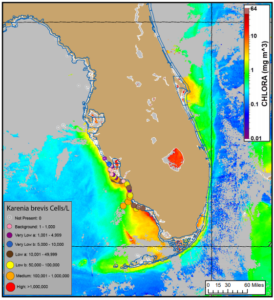
Karenia brevis cell concentration sampling data from: 02/08/21 through 02/16/21. Cell count data are provided by Florida FWC Fish and Wildlife Research Institute. Credit: NOAA Tides and Currents Gulf of Mexico Harmful Algal Bloom Forecast.
A red tide event caused by the organism Karenia brevis, which produces brevetoxin, persists off the coast of Southwest Florida. Bloom conditions improved during late January and early February, however an unusually high number of juvenile royal terns (Thalasseus maximus) and double-crested cormorants (Phalacrocorax auritus) were found dead or displaying neurological impairment indicative of brevetoxicosis. Preliminary samples confirmed that brevetoxins were found at levels equal to or higher than those reported for seabirds previously diagnosed with brevetoxicosis.
Cormorants and royal terns feed offshore, at depths of up to 8 meters (24 feet) and 2 meters (7 feet), respectively. Scientists hypothesize that these birds consumed prey fish impacted by red tide cells located below the ocean's surface, before the bloom could be detected by satellites. At the time these birds were collected, high concentrations of K. brevis were not detected in surface waters assessed via water sampling or remote sensing. However, by mid February 2021, water samples revealed bloom concentrations of K. brevis near Sanibel Island. The birds may serve as ‘sentinel’ species for blooms brewing beneath the ocean's surface before the red tide can be detected by current observing methods. The adverse impact this red tide event has had on young, fish-eating seabirds presents an opportunity to evaluate brevetoxin bioaccumulation in these potential ‘sentinel’ species and their prey.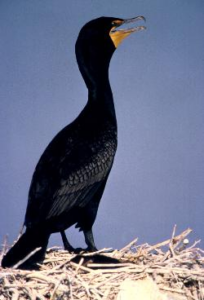
This funding supports analysis of bird and prey fish samples for brevetoxins and stable isotopes. The results, which will determine whether these species can be reliably leveraged as sentinels for soon-to-emerge blooms, will be shared with regional partners who oversee red tide water quality sampling efforts, remote sensing detection efforts (NOAA HAB monitoring and CoastWatch programs), and wildlife rehabilitation and management efforts. Findings from this work will also inform when and where subsurface and surface water sampling and detection efforts should be focused in the future.
The NCCOS HAB Event Response Program provides immediate assistance to help federal, state, and local officials manage events and advance the understanding of HABs as they occur.
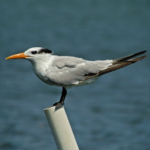
A double-crested cormorant (top) and a royal tern. Credit: US Fish and Wildlife Service
For more information, visit the NCCOS Harmful Algal Bloom Event Response Program webpage.
NOAA’s National Centers for Coastal Ocean Science (NCCOS) provided a HAB Event Response award of $48,000 to the Qawalangin Tribe of Unalaska, Agdaagux Tribe of King Cove, Aleut Community of St. Paul Island, and Qagan Tayagungin Tribe of Sand Point. This funding will provide temporary support to continue and expand regular and consistent testing for Paralytic Shellfish Poisoning (PSP) toxins in shellfish, and phytoplankton identification along the Aleutian and Pribilof Islands.
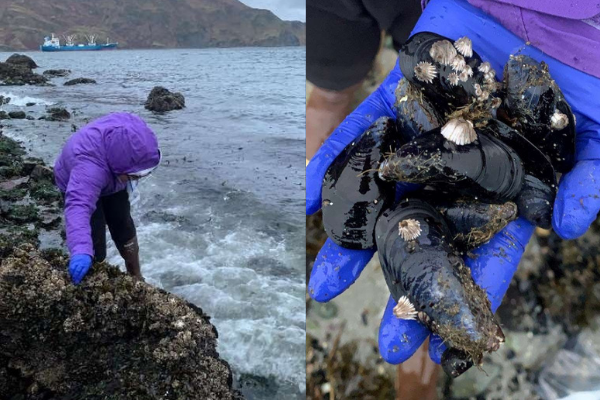
Mussel sampling in Unalaska, Alaska. Credit: Lisa Tran, Qawalangin Tribe of Unalaska.
The southern Bering Sea and the Gulf of Alaska experienced unusually warm ocean temperatures during the summer of 2020, which might have increased the likelihood of harmful algal blooms (HABs). Previous reports of Alexandrium cysts, cells, and toxins in Arctic waters confirm the presence of HAB species in this region. Alexandrium species are often responsible for the production of PSP toxins, which can impact human health. This past spring and summer, unprecedented levels of PSP toxins were found in shellfish collected at locations along the Aleutian Islands chain and Alaska Peninsula. PSP toxins measured in blue mussels, snails, and butter clams collected from King Cove, Sand Point, and Unalaska were frequently above the FDA limit for safe consumption, sometimes as much as 100 times. Consumption of blue mussels and snails resulted in a fatality in Unalaska, AK in early July 2020. These regional data suggest a widespread HAB event led to elevated toxin levels in shellfish.
The funding supports consistent, monthly collection and analysis of blue mussels, limpets, and butter clams at six locations across the four Tribal communities, from August 2020 through September 2021. Samples of mussels, limpets, and clams are being sent to the Alaska Department of Environmental Conservation Laboratory (ADEC) for analysis. Funds are also provided to purchase equipment and supplies needed to monitor phytoplankton. The Tribes will work closely with the Kachemak Bay National Estuarine Research Reserve and NOAA NCCOS Phytoplankton Monitoring Network to learn to identify toxin-producing HAB species and establish a monitoring capacity to support future development of predictive models or HAB early warning systems.
Results from ADEC will be made available to the public via the Qawalangin Tribe social media platforms and website, and distributed through each community by environmental staff. Qawalangin Tribe staff will attend monthly phone calls of the Alaska Harmful Algal Bloom (AHAB) network to share data with the larger interested community of researchers and others working in harmful algal blooms and PSP. Data from this study will not be used for human food safety information, but will serve as a way to better understand what is happening in shellfish and the waters surrounding the harvesting locations. The only safe way to consume shellfish in the region continues to be purchasing them from a commercial source.
Additional Resources:
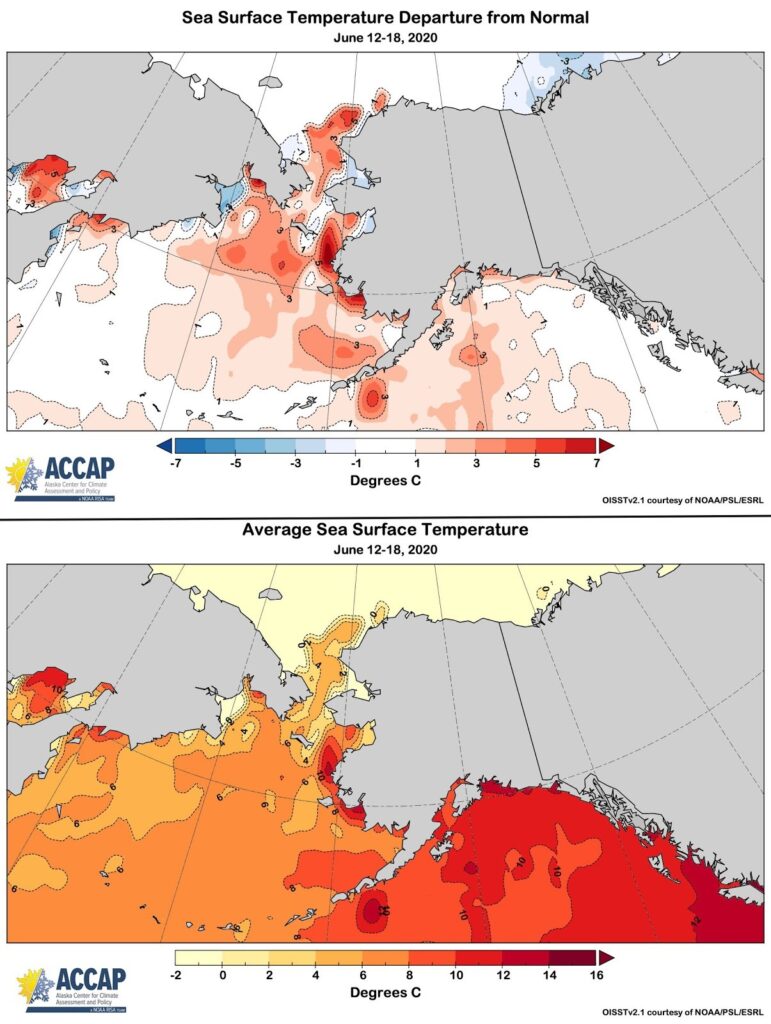
Sea surface temperatures along the Aleutian Islands chain and Alaska Peninsula were unusually warm, which may increase the likelihood of harmful algal blooms in this region. Graphic by University of Alaska Fairbanks, Alaska Center for Climate Assessment & Policy
For more information, visit the NCCOS Harmful Algal Bloom Event Response Program webpage.
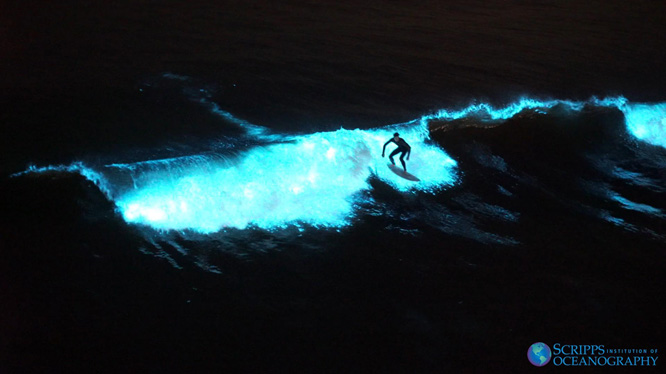
A surfer rides a bioluminescent wave from a bloom of L. polyedra. Credit: Dr. Michael Latz, Scripps Institution of Oceanography.
NOAA’s National Centers for Coastal Ocean Science awarded $16,000 in Harmful Algal Bloom Event Response funding for researchers at Scripps Institution of Oceanography and the Southern California Coastal Ocean Observing System (SCCOOS) to investigate a bioluminescent algal bloom and co-occurrence of low dissolved oxygen off the coast of Southern California, from the Channel Islands in California to Cedros Island in Mexico. The NCCOS Harmful Algal Bloom Monitoring System is also providing satellite remote sensing images of the event to determine the extent of the bloom of Lingulodinium polyedra (formerly Lingulodinium polyedrum).
The bloom was first detected in late March 2020 by an Imaging FlowCytobot (IFCB) at a mooring near Del Mar, California. The IFCB combines flow cytometric and video technology to capture high resolution images of suspended particles. A month later, weekly sampling at Scripps Pier by the California Harmful Algal Bloom Monitoring and Alert Program (HABMAP) and SCCOOS yielded the highest abundance of L. polyedra ever recorded over a 37-year period.
The bloom lasted at least two months, creating spectacular shows of bioluminescence at local beaches, but was followed by a sudden appearance of dead fish, crab, mussels, and invertebrates along San Diego, Orange County, and northern Baja coasts. Aquaculture facilities and research aquaria that used seawater from piers near bloom-impacted locations also experienced significant losses of stocks and specimens.
The cause of these massive die-offs is still unknown, and might be attributed to low oxygen conditions from the prolonged bloom, toxin produced by L. polyedra, or other bacterial byproducts that may form as the bloom degrades. L. polyedra produces yessotoxin, which can bioaccumulate in many organisms. To date, toxicological data on the effects of yessotoxin are largely incomplete. However, researchers ultimately attributed mortalities of abalone during an L. polyedra bloom in 2011 in northern California to yessotoxin.
Surfers and beachgoers in the region reported itching, development of hives, and respiratory hypersensitivity during the 2020 L. polyedra bloom. There is concern that blooms may increase yessotoxin production (and possibly aerosolization of the toxin) or bacterial byproducts that may cause irritation, allergic response, or toxic conditions for humans and marine life. However, the chemical nature of the compounds produced by L. polyedra that may induce allergic reactions are unknown.
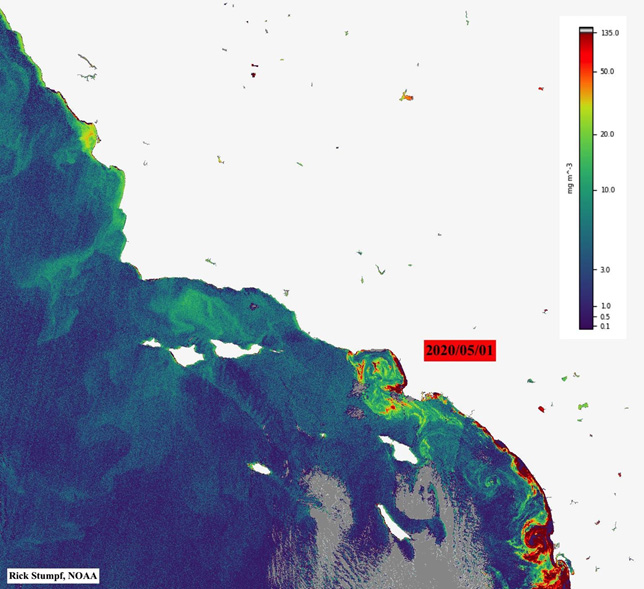
Satellite Image of chlorophyll concentration showing extent of bloom (red) off the coast of Southern California, May 1, 2020. Credit: NOAA processed data derived from the Copernicus Sentinel 3 satellite.
The award supports the analysis of environmental and wildlife samples for the presence and bioaccumulation of yessotoxins, as well as investigation into the causes of the animal die-off and public health implications. Scripps researchers will work closely with the Southern California Coastal Water Research Program (SCCWRP) to monitor the severity of the bloom and the potential public health impacts. Data produced by this project will better describe bloom dynamics, the causes of animal mortality, and will be included in the SCCOOS Spring 2020 Red Tide Bulletin, which is distributed widely to scientists, stakeholders, and the public.
The NCCOS HAB Event Response Program provides immediate assistance to help federal, state, and local officials manage events and advance the understanding of harmful algal blooms as they occur. The NCCOS Harmful Algal Bloom Monitoring System routinely delivers near–real-time products for use in locating, monitoring, and quantifying algal blooms in coastal and lake regions of the U.S.
For more information, visit the NCCOS Harmful Algal Bloom Event Response Program webpage.
NOAA's National Centers for Coastal Ocean Science provided a Harmful Algal Bloom Event Response award of $11,640 to the University of South Alabama and the Dauphin Island Sea Lab (DISL) to evaluate cyanobacterial bloom impacts in the northern Gulf of Mexico.
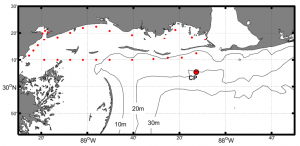
Map of proposed sampling sites (red dots) in Mississippi and Alabama. Surveys will be conducted and samples collected once a week from nearshore and offshore transects for three consecutive weeks. The site labeled CP is a long-term monitoring buoy on the 20-meter isobath maintained by the Dauphin Island Sea Lab and equipped with a variety of sensors. Samples and data from this site will also be monitored with high frequency. Credit. Dauphin Island Sea Lab.
Vast inputs of freshwater and suspended materials from the Mississippi River are released into the northern Gulf of Mexico ecosystem via rivers, natural openings, and spillways and diversions that prevent or control flooding. The US Army Corps of Engineers New Orleans District operates the Bonnet Carré Spillway, which was opened for two lengthy periods between February 27 and July 27, 2019 to prevent flooding after heavy rains in the Mississippi and Ohio River valleys increased river stages. Persistent low salinity conditions, blooms of toxic cyanobacteria, hypoxia, and mortalities in oysters, dolphins, sea turtles, and other marine species are occurring across the northern Gulf of Mexico. NOAA Fisheries declared an Unusual Mortality Event (UME) due to elevated bottlenose dolphins stranding from Louisiana to the Florida panhandle. Beach advisories have been issued throughout the region to prevent exposure to cyanobacterial toxins.
This award supports sample collection and analyses for detection of harmful algae and cyanobacterial toxins to better understand bloom dynamics and drivers, and potential food web impacts including risks to humans. Changes in phytoplankton community assemblages and associated toxin production in the coastal environment will be evaluated along with environmental measurements including salinity and dissolved oxygen. Partners include the Mississippi Department of Marine Resources and the Alabama Marine Mammal Stranding Network, as well as researchers from Auburn University and Bowling Green State University. Data will be shared with scientists and managers across the region, including coordination with event response efforts ongoing in Lake Pontchartrain. These data will support outreach and risk communication efforts by Mississippi Alabama Sea Grant and will inform the Northern Gulf of Mexico Bottlenose Dolphin Unusual Mortality Event investigation.
The NCCOS HAB Event Response Program provides immediate assistance to help federal, state, and local officials manage events and advance the understanding of HABs as they occur.
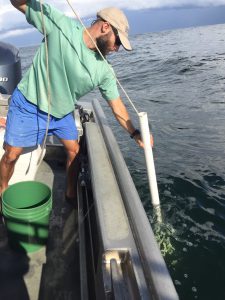
Graduate student Clayton Bennett (DISL) collects an integrated surface sample offshore aboard DISL small boat R/V Pelagia, Credit. A. Robertson, DISL
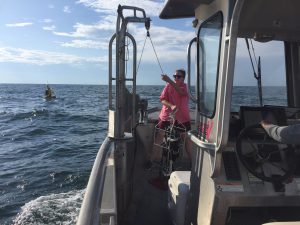
Intern Jackie Wilson (DISL) deploys a small CTD aboard the DISL small boat R/V Pelagia. Credit. A. Robertson, DISL
For more information, visit the NCCOS Harmful Algal Bloom Event Response Program webpage.
NOAA's National Centers for Coastal Ocean Science provided a Harmful Algal Bloom Event Response award of $15,000 to NOAA’s Northwest Fisheries Science Center Wildlife Algal-toxin Research and Response Network (WARRN-West) to determine the role of algal toxins in wildlife mortalities occurring in the Norton Sound region of Alaska.
The Bering and Chukchi Seas are experiencing unusually warm ocean temperatures, which may increase the likelihood of harmful algal blooms (HABs). Previous reports of marine mammal exposure to HAB toxins in the Bering Sea, and of the presence of Alexandrium cysts, cells, and toxins in Arctic waters confirm the presence of HAB species in this region. These factors provide cause to investigate the role of HAB toxins in the current multispecies mortality event that is taking place in the north Bering Strait and Norton Sound regions. Mortalities include birds, fish, krill, clams, a bowhead whale, a minke whale, ice seals, and walruses.
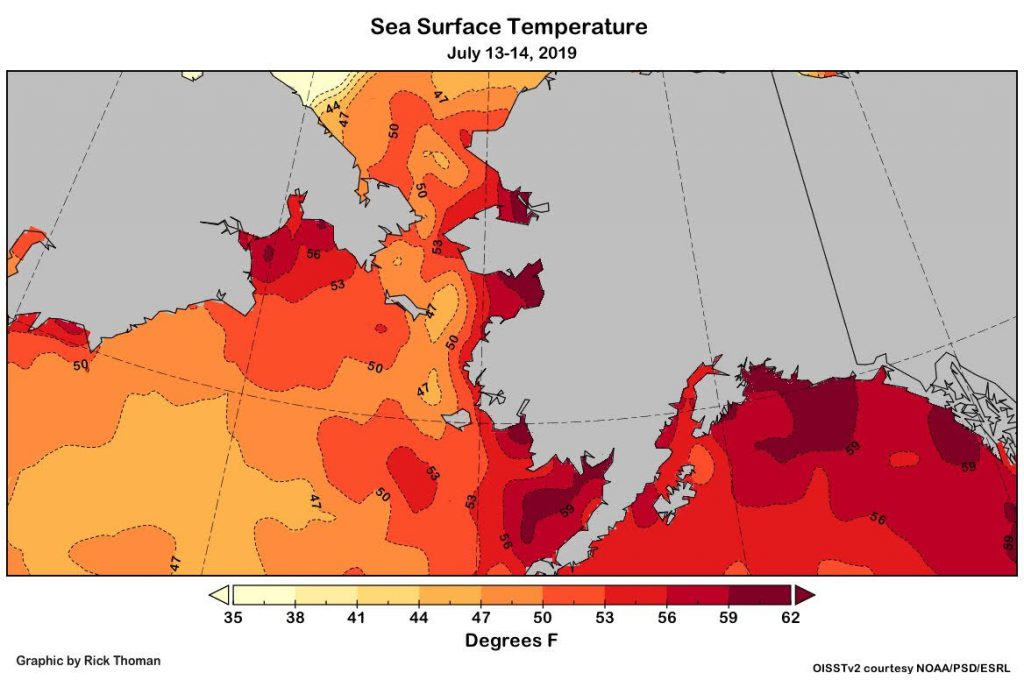
Sea surface temperatures in the northern Bering Sea are unusually warm, which may increase the likelihood of harmful algal blooms in this region. Graphic by Rick Thoman, University of Alaska Fairbanks.
This award supports environmental and wildlife sample collection, and analyses for detection of algal toxins that may be harmful to wildlife and people in Alaska. NOAA scientists will work directly with regional partners, including Alaska Sea Grant and the Alaska Harmful Algal Bloom Network, and local communities to communicate results from this emergency response. Food security is a major concern in Alaskan Native communities, where subsistence harvests comprise seals, sea lions, walruses and whales. Subsistence hunting is critical for nutrition in Alaskan Native communities.
The NCCOS HAB Event Response Program provides immediate assistance to help federal, state, and local officials manage events and advance the understanding of HABs as they occur.
For more information, visit the NCCOS Harmful Algal Bloom Event Response Program webpage.
NOAA’s National Centers for Coastal Ocean Science provided a HAB Event Response award of $12,900 to the Louisiana State University (LSU) and Lake Pontchartrain Basin Foundation (LPBF). This award will fund their efforts to monitor shoreline areas commonly used for recreation around the lake for levels of algal toxins that could be harmful to people or their pets during recreational use. The NCCOS Harmful Algal Bloom Monitoring System is also providing satellite remote sensing images of the cyanobacterial blooms to inform decisions about sampling.
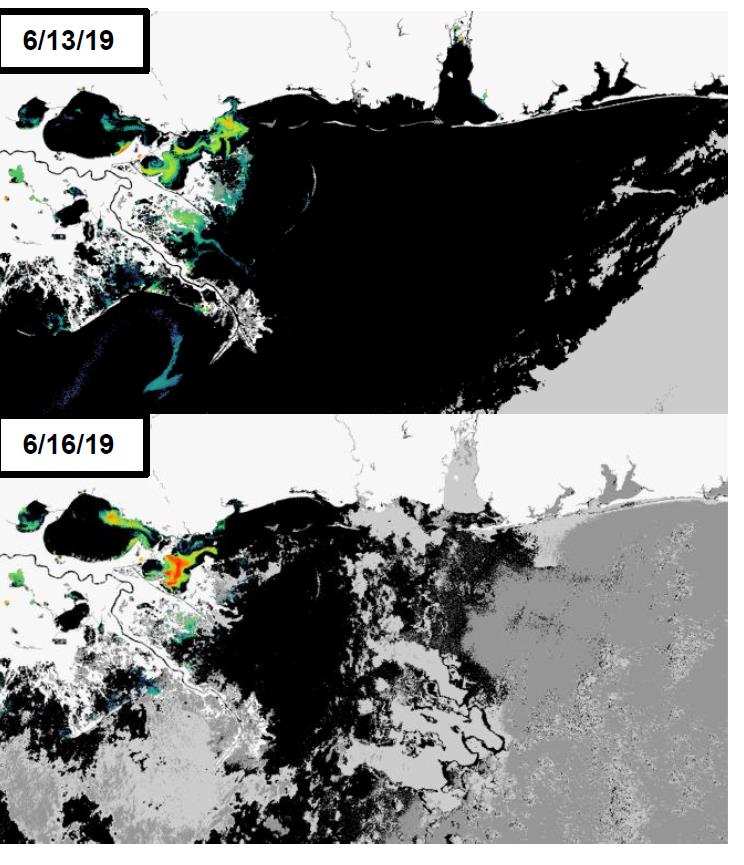
Satellite Image The red areas show the peak of the cyanobacterial bloom in the Lake Pontchartrain and Lake Borgne regions (dark areas at upper left. The Gulf of Mexico is the large dark area to the right. The Mississippi River Delta (aka bird’s-foot delta) is the NW-SE protruding light colored land mass at left-center. Credit NOAA derived image from Sentinel-3A satellite.
This bloom originated from the introduction of large volumes of nutrient-rich fresh river water, from the opening of the Bonnet Carré Spillway, into the lower nutrient, estuarine Lake Pontchartrain. Freshwater inputs from the spillway have been shown to substantially change the chemistry and ecology of the lake. Spillway openings can rapidly depress lake salinities, causing most of the lake to become fresh which can persist for several months, when seasonal weather or tropical activities introduce saltwater from the Gulf of Mexico into the lake. Preliminary field results investigating the bloom composition identified the abundance of cyanobacterial species known to produce a variety of cyanobacterial toxins. These toxins have the potential for causing human illnesses. Previous spillway openings have been associated with toxic cyanobacteria blooms, and there is a concern that blooms could occur in shoreline areas utilized by the public, possibly exposing people and/or their pets to harmful levels of algal toxins.
LPBF and LSU will conduct weekly field water quality monitoring, sample collection, and analysis. Monitoring will occur at sites along the north and south shorelines of Lake Pontchartrain. The sampling effort will be aided by NOAA providing imagery from the Sentinel-3 satellites. These satellites measure coastal water color, which shows the location of harmful cyanobacteria blooms. If significant blooms are detected in the lake using satellite images, monitoring intensity will be increased, with more frequent, weekly monitoring at baseline sites as well as additional sites. Monitoring will continue after the spillway is closed, when an expected decrease in turbidity throughout the lake would be conducive to widespread algal growth, until the end of summer. By then the likelihood of a bloom and the risk to people and pets is expected to be low due to decreasing water temperatures and increasing salinities that are unfavorable to the growth of toxic cyanobacteria.
This award will fund HAB identification and counts and biotoxin analyses for duration of the event; samples will be collected for later nutrient analyses. LSU and LPBF researchers and staff will work closely with Louisiana Department of Health, Environmental Protection Agency, and U.S. Army Corps of Engineers to closely monitor the severity of the bloom and potential public health impacts.
For more information, visit the NCCOS Harmful Algal Bloom Event Response Program webpage.
NOAA’s National Centers for Coastal Ocean Science provided a Harmful Algal Bloom Event Response award of $15,000 to NOAA’s Northwest Fisheries Science Center Wildlife Algal-toxin Research and Response Network (WARRN-West) to determine the role of algal toxins in wildlife mortalities occurring in the Norton Sound region of Alaska.
The Bering and Chukchi Seas are experiencing unusually warm ocean temperatures, which may increase the likelihood of harmful algal blooms (HABs). Previous reports of marine mammal exposure to HAB toxins in the Bering Sea, and of the presence of Alexandrium cysts, cells, and toxins in Arctic waters confirm the presence of HAB species in this region. These factors provide cause to investigate the role of HAB toxins in the current multispecies mortality event that is taking place in the north Bering Strait and Norton Sound regions. Mortalities include birds, fish, krill, clams, a bowhead whale, a minke whale, ice seals, and walruses.
This award supports environmental and wildlife sample collection, and analyses for detection of algal toxins that may be harmful to wildlife and people in Alaska. NOAA scientists will work directly with regional partners, including Alaska Sea Grant and the Alaska Harmful Algal Bloom Network, and local communities to communicate results from this emergency response. Food security is a major concern in Alaskan Native communities, where subsistence harvests comprise seals, sea lions, walruses and whales. Subsistence hunting is critical for nutrition in Alaskan Native communities.
For more information, visit the NCCOS Harmful Algal Bloom Event Response Program webpage.
NOAA’s National Centers for Coastal Ocean Science provided a Harmful Algal Bloom Event Response award of $11,640 to the University of South Alabama and the Dauphin Island Sea Lab (DISL) to evaluate cyanobacterial bloom impacts in the northern Gulf of Mexico.
Vast inputs of freshwater and suspended materials from the Mississippi River are released into the northern Gulf of Mexico ecosystem via rivers, natural openings, and spillways and diversions that prevent or control flooding. The US Army Corps of Engineers New Orleans District operates the Bonnet Carré Spillway, which was opened for two lengthy periods between February 27 and July 27, 2019 to prevent flooding after heavy rains in the Mississippi and Ohio River valleys increased river stages. Persistent low salinity conditions, blooms of toxic cyanobacteria, hypoxia, and mortalities in oysters, dolphins, sea turtles, and other marine species are occurring across the northern Gulf of Mexico. NOAA Fisheries declared an Unusual Mortality Event (UME) due to elevated bottlenose dolphins stranding from Louisiana to the Florida panhandle. Beach advisories have been issued throughout the region to prevent exposure to cyanobacterial toxins.
This award supports sample collection and analyses for detection of harmful algae and cyanobacterial toxins to better understand bloom dynamics and drivers, and potential food web impacts including risks to humans. Changes in phytoplankton community assemblages and associated toxin production in the coastal environment will be evaluated along with environmental measurements including salinity and dissolved oxygen. Partners include the Mississippi Department of Marine Resources and the Alabama Marine Mammal Stranding Network, as well as researchers from Auburn University and Bowling Green State University. Data will be shared with scientists and managers across the region, including coordination with event response efforts ongoing in Lake Pontchartrain. These data will support outreach and risk communication efforts by Mississippi Alabama Sea Grant and will inform the Northern Gulf of Mexico Bottlenose Dolphin Unusual Mortality Event investigation.
For more information, visit the NCCOS Harmful Algal Bloom Event Response Program webpage.
NOAA’s National Centers for Coastal Ocean Science (NCCOS) provided an Event Response award of $5,000 to Florida Gulf Coast University to aid efforts to identify whether cyanobacterial (blue-green algae) blooms of Microcystis active around Cape Coral, Florida, are producing airborne toxins or particles.
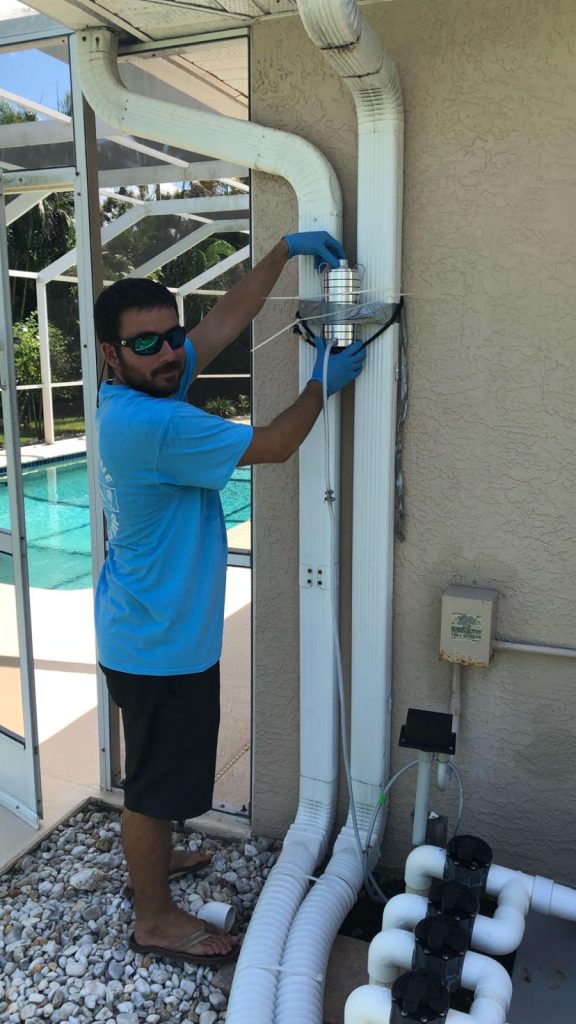
Florida Gulf Coast University graduate student Adam Catasus installs an algae air-sampling pump outside a Cape Coral home. Credit: Dr. Mike Parsons, FGCU.
For several months in 2018, intensive Microcystis blooms have plagued communities along the tidal Caloosahatchee River and adjoining canals around Cape Coral, Florida. The Florida Department of Environmental Protection (FLDEP) has been conducting monthly sampling in the area and reporting on the presence of Microcystis aeruginosa and microcystin toxin concentrations. On September 17, 2018, FLDEP measured microcystin concentrations of 46 μg L-1 (micrograms per liter). According to the World Health Organization, microcystin concentrations greater than 20 μg L-1 in recreational waters are considered “high risk” for acute health effects.
With microcystins present in coastal waters near Cape Coral communities, residents have expressed concerns about health risks from exposure to microcystins via inhalation of aerosols or particles (i.e., “algal dust”). However, there is no conclusive scientific evidence to date of an airborne vector for microcystin exposure.
To address this question, the research team developed a pilot air sampling program, and in September 2018 began collecting air filter samples from a site along the tidal Caloosahatchee River next to an ongoing Microcystis bloom, along with samples from a control site without a bloom. Air samplers were run from September 21 to October 11, 2018 and water samples were collected too, before and after deployments at each site. The goal of the program is to determine whether toxin and cell particles are present and to identify particle sizes. As particle sizes decrease they can be more deeply inhaled into the lungs, allowing any associated toxins or other bioactive compounds to more easily enter the bloodstream.
NCCOS Event Response Program funding will cover costs to analyze air samples and water samples using DNA sequencing to determine the presence or absence of Microcystis. Microcystins will be tested using an ELISA (enzyme-linked immunosorbent assay) test kit. The project is led by Dr. Michael Parsons (Florida Gulf Coast University), and involves researchers from Yale University and Cape Coral Environmental Resource Division. Results will be shared with personnel from Cape Coral, Lee County, and FLDEP. The researchers will also investigate potential expansion of the pilot monitoring program and linkages with other human health research groups.
For more information, visit the NCCOS Harmful Algal Bloom Event Response Program webpage.
NOAA’s NCCOS’ HAB Event Response Program provided $10,045 in Fiscal Year 2018 funding for a project led by the Sanibel Captiva Conservation Foundation (SCCF) that aims to learn more about sea turtle diets and how the toxicity of their food can impact turtle mortality rates during red tides.
A bloom of the red tide organism Karenia brevis, which produces brevetoxins, has waxed and waned off the coast of Southwest Florida since October 2017. Humans and animals may be exposed to brevetoxins by eating contaminated food or by breathing in aerosolized (airborne) toxins. The current bloom has had severe economic effects across the region, affecting tourism and the seafood industry. The bloom also has caused extensive mortalities in sea turtles and other marine life. Sea turtle strandings are especially high during K. brevis red tides, and many turtles that have stranded have tested positive for brevetoxins.
This project will explore connections between sea turtle mortalities and brevetoxins in partially digested food sources – including seagrass leaves, shellfish, fish, or sponges – found in the turtles’ digestive system. The data collected will inform our understanding of how turtles become sick when exposed to brevetoxins through the foods they eat, and how pervasive the toxins are in coastal food webs important to sea turtles. Managers may use these data to determine if altering prey availability through managed harvests could reduce the impacts of brevetoxin on sea turtles.
The NCCOS HAB Event Response program will fund screening tests and confirmatory analytical analyses to determine the presence and levels of brevetoxins in gut contents and tissues in samples collected from stranded turtles and their digested prey. SCCF staff will work with the NOAA NCCOS Analytical Response Team, the Conservancy of Southwest Florida, and the Clinic for the Rehabilitation of Wildlife.
For more information, visit the NCCOS Harmful Algal Bloom Event Response Program webpage.
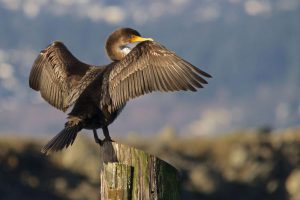
A double crested cormorant spreads its wings. Credit: US FWS
The NCCOS Harmful Algal Bloom Event Response Program awarded $8,250 to Florida’s Clinic for the Rehabilitation of Wildlife (CROW) and the Florida Fish and Wildlife Conservation Commission Fish and Wildlife Research Institute (FWRI) to study a novel treatment for cormorants sickened by exposure to brevetoxin resulting from red tide. The results could provide insight for treating other marine animals in the future.
A bloom of the red tide organism Karenia brevis, which produces brevetoxin, has persisted and expanded off the coast of Southwest Florida since October 2017. The bloom has led to the deaths of fish, sea birds, marine mammals, and turtles, which are exposed to the toxin either via their diet or breathing in airborne toxins. In humans, the health impacts of brevetoxin can range from itchy, watery eyes, to a severe cough, to gastrointestinal or neurotoxic effects.
Wildlife rehabilitation centers have been overwhelmed with sick animals and struggle to provide effective treatments. Additionally, the red tide has severely impacted the region’s economy, as the bloom is deterring tourists and leading to closures of shellfish beds and beaches to protect public health.
CROW’s study is investigating the effects of a high-lipid emulsion therapy on cormorants that are sickened with brevetoxicosis. This method has previously proven effective in treating other, similar types of neurotoxin illnesses in different animal species. In cormorants, survival rates have increased 22 percent in treated birds.
This event response funding supports testing for the presence and levels of brevetoxin in the cormorants’ plasma following treatment, in order to demonstrate the efficacy of the therapy. Should the findings support the survival data, the method can be expanded to treating other marine life. This is particularly timely going into the fall, when K. brevis typically thrives near shore.
For more information, visit the NCCOS Harmful Algal Bloom Event Response Program webpage.
A relatively small, one-time NCCOS funding contribution to aid the study of red tide off southwest Florida has helped produce an unexpected long-term benefit – the establishment of a citizen science initiative to monitor for red tide and a previously unknown low dissolved oxygen “dead zone” off the southwest coast of Florida.
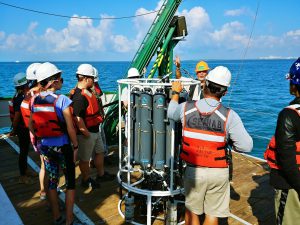
Scientists and Captain Casey Streeter aboard the R/V F. G. Walton Smith standby to deploy a rosette-type water sampler during the October 12-19, 2018, SW Florida red tide cruise. Credit NOAA AOML
NCCOS Event Response funding, in tandem with additional funding from NOAA’s Southeast Fisheries Science Center (SEFSC), helped support an October 2018 research cruise aboard the R/V F.G. Walton Smith, led by Dr. Christopher Kelble of NOAA’s Atlantic Oceanographic and Meteorological Laboratory (AOML). NCCOS and SEFSC contributions helped to extend the cruise by 3 days, and allowed local fisherman, Casey Streeter, to participate in the cruise. The main focus of the cruise was to quantify human health and ecosystem impacts of the 2017-2018 massive red tide event. Streeter also directed scientists to areas of concern for local fisherman, which resulted in the discovery of a previously undiscovered southwest Florida dead zone.
NOAA/SEFSC stakeholder workshops focusing on the southwest Florida coast identified serious citizen concerns regarding red tide impacts on fish populations and habitat. Red tide was impacting not only the fish populations that commercial and for-hire fishing businesses depend upon, but other aspects of fishing communities such as aquaculture, recreational fishing, tourism, local seafood markets, and real estate values. The newly discovered dead zone heightened citizen concerns.
A celebrated outcome of the research cruise (funded in part by NCCOS and SEFSC) was the establishment of a NOAA-supported citizen science initiative to help NOAA and its Florida partners monitor water quality off the southwest Florida shelf. The Florida Commercial Watermen’s Conservation (aka Florida Watermen), a group of commercial fishermen, are now contributing their own water quality testing to help NOAA and the broader scientific community gain a better understanding of water quality issues and red tide events. AOML receives and quality controls the data from the Florida Watermen, before submitting it to the Gulf of Mexico Coastal Ocean Observing System (GCOOS).\
In addition to water testing kits, the Florida Watermen were also equipped with a new “HABscope”, an instrument provided by NOAA and GCOOS that combines smartphone technology with a microscope, to help monitor the abundance of red tide species. By using the HABscope and sampling offshore, commercial fisherman can identify and provide an early warning to beachgoers of possible respiratory irritation risks from an approaching red tide bloom before it reaches shore.
NCCOS is pleased to have contributed to the success of this new government/citizen science success story. Through the NCCOS Harmful Algal Bloom Event Response Program, NCCOS is providing local organizations with modest financial support to defray event response costs, such as mobilization of sampling, supplies, and analytical services.
Read more about the NCCOS HAB Event Response for Florida red tide here.
On August 14, NOAA’s National Centers for Coastal Ocean Science provided an Event Response award of $19,200 to the Florida Fish and Wildlife Research Institute (FWRI) and Mote Marine Laboratory. The award will supplement their efforts to document and understand changes in the severity, duration, and location of the ongoing red tide along the southwest coast of Florida.
The bloom of the red tide alga, Karenia brevis, originated offshore of southwest Florida in October 2017. It intensified and moved closer to shore in June 2018, extending 130 miles and affecting seven Florida counties. Blooms of K. brevisproduce brevetoxin, which kills fish and makes shellfish dangerous to eat. The toxins can become airborne through wave action and may cause respiratory irritation for people on or near beaches.
The bloom is taking an increasing toll on marine animals, including fish, sea turtles, birds, dolphins, and manatees. There are multi-million dollar economic impacts to the shellfish and tourism industries. Shellfish harvesting closures are necessary to protect human health and beach recreation, hotels and restaurants, and charter boats, are losing customers as people avoid areas with dead fish, strong odors, and air quality warnings.
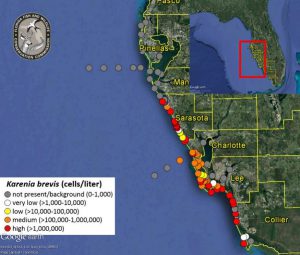
Weekly HAB report from July 30–August 3, 2018 showing sampling conducted by FWRI in southwest Florida, including transect lines off Tampa Bay (sampled monthly for over a year) and Charlotte Harbor (sampled weekly since July). Credit: FWRI.
FWRI and Mote will conduct weekly one-day sampling efforts along a four-station transect line from three to 30 miles offshore in the impacted area near Boca Grande Pass. The award will fund expanded nutrient and biotoxin analyses for four weeks. The data are critical to predicting and mitigating impacts from this and future events. Continued and more severe impacts to fisheries, wildlife, human health and the local economy are likely as the bloom transitions into the late summer-fall period when K. brevis blooms typically thrive near shore.
For more information, visit the NCCOS Harmful Algal Bloom Event Response Program webpage.
NCCOS has provided the Sitka Tribe of Alaska with funding to expand monitoring and toxin testing of an active bloom of Pseudo-nitzschia in the city of Sitka’s coastal waters in southeast Alaska. Some species of the marine alga Pseudo-nitzschia produce domoic acid, a potent neurotoxin that can accumulate in shellfish that feed on Pseudo-nitzschia and can lead to amnesic shellfish poisoning in people who eat tainted shellfish.
In July, elevated concentrations of Pseudo-nitzschia at tribal monitoring sites around the city of Sitka raised concerns about domoic acid, prompting the Sitka Tribe of Alaska Environmental Research Laboratory (STAERL) to increase algal monitoring. Water sampling results revealed a toxic Pseudo-nitzschia bloom threatening Sitka community shellfish harvesting.
In Alaska, commercially harvested shellfish sold in stores and restaurants meet federal Food and Drug Administration–approved and state-run toxin testing requirements and are safe to eat. However, there is no routine state-run algal toxin testing of shellfish harvested for recreation, subsistence, or ceremonial use.
To ensure access to safe shellfish and increase regional food security for southeast Alaska, the Sitka Tribe of Alaska formed the Southeast Alaska Tribal Ocean Research (SEATOR) partnership, which monitors harvest locations for harmful algal blooms, their toxins, and other threats. SEATOR now includes 16 tribal governments and monitors over 30 sites using sampling techniques and toxin analysis methods developed and transferred from NCCOS scientists and the NOAA Phytoplankton Monitoring Network. Historically, paralytic shellfish toxins have been the most significant algal toxin threat to subsistence harvesters, but with the emergence of domoic acid, STAERL and SEATOR capabilities are strained.
The NCCOS Harmful Algal Bloom Event Response Program funding will equip STAERL and partners with test kits and filter supplies needed for a comprehensive rapid screening across SEATOR subsistence harvesting sites. The effort will leverage expertise at NOAA’s Northwest Fisheries Science Center for confirmatory identification of local Pseudo-nitzschia species. Results will help STAERL assess the feasibility of adopting a multi-level phytoplankton and water sample domoic acid screening process similar to the one used in the state of Washington for effective early warning of shellfish toxicity. Domoic acid is expected to become a greater threat to subsistence shellfish harvesting in southeast Alaska as water temperatures increase.
An additional threat of the bloom is to other migratory fowl and local fauna that use the pond as a freshwater drinking source. Since little is known about the trophic transfer of microcystins, a secondary concern is the potential impact to the local ecosystem when scavengers eat dead ducks. Given thelack of knowledge about the long-term persistence of the toxin in exposed ducks, the potential threat to human health due to the redhead duck popularity with mid-western hunters is also being considered.
While hydrogen peroxide is generally considered safe, researcherswill test the minimum effective dose in pond enclosures that mimic natural conditions before treating the pond and carefully monitor water quality and toxicity in the enclosures and later in the pond. They will take various precautions to minimize treatment impacts to other aquatic life and wildlife in the area.
While the NCCOS Prevention, Control, and Mitigation of HABs program funded research on HAB control since 2010, this is the first Event Response award for HAB control.
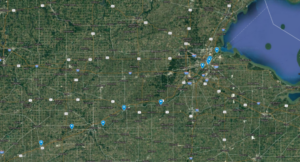
Sites samples along the Maumee River. Credit: NOAA
Concerns regarding a large cyanobacteria harmful algal bloom (HAB) of Microcystis spp. and Planktothrix spp., which developed on the Maumee Riveradjacent to Toledo, Ohio in mid-September, led NCCOS to provide event response funds for initial testing and monitoring of the HAB for toxins.
A team led by Bowling Green State University, including University of Toledo, State University of New York College of Environmental Science and Forestry, Ohio EPA, and Defiance College will analyze water samples to measure the concentrations of a broad suite of CyanoHAB toxins and the genetic potential for toxin production. Samples were collected from the entire bloom, which stretches along the river for approximately 10 miles to its mouth at Lake Erie (see map). This will provide Ohio water resource managers with important information necessary for protecting human and animal health.
This bloom is unusual for a number of reasons. It is late in the year for a HAB to develop, particularly given recent lack of rainfall in the area that ordinarily may contribute to a bloom. Additionally, this type of bloom does not frequently occur on the Maumee River, although high temperatures, lack of flow and particular wind patterns may be contributing to its development and persistence. The response will inform recreational usage and protect source waters that support multiple Ohio public water systems and the food processing industry. The cities of Napoleon, Bowling Green, and Defiance, as well as the the Campbell Soup Napoleon Manufacturing Facility, have requested information about bloom toxicity.
For the first time in New England’s coastal waters, shellfish have exceeded the regulatory limit for domoic acid – a potent neurotoxin produced by the diatom Pseudo-nitzschia. Domoic acid accumulates in shellfish that feed on Pseudo-nitzschia, and can lead to amnesic shellfish poisoning in people who consume tainted shellfish.
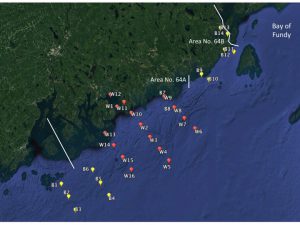
Multiple mapping cruises took place in early October, covering both waters where shellfish closures have occurred and waters without closures but where blooms were present. Credit: K. Hubbard.
The NCCOS Harmful Algal Bloom Event Response Program awarded funds to the Woods Hole Oceanographic Institution and the Bigelow Laboratory for Ocean Sciences to rapidly map the spatial extent, species composition, and toxicity of thePseudo-nitzschiabloom in the coastal and nearshore waters of the Gulf of Maine, and to determine the oceanographic conditions contributing to the bloom’s toxicity and distribution. Maine state managers are using these data to inform shellfish harvest closures and mitigate the impact of the unfolding bloom.
Blooms ofPseudo-nitzschiahave also been observed in Massachusetts and Rhode Island. Weekly coordination calls between state agencies, researchers, and NOAA are also helping Massachusetts and Rhode Island respond to this ongoing regional bloom.
Earlier NCCOS and partner harmful algal bloom research in the region has documented the presence ofPseudo-nitzschiaspeciescapable of producing toxins and alerted shellfish managers to this potential threat. Those efforts focused on providing agencies with better detection technology and monitoring methods and have provided some capacity that has aided the rapid response to the current bloom.
Landsat 8 true color image of northern Indian River Lagoon system from April 4, 2016. Credit: St. Johns River Water Management District.
A team led by theHarbor Branch Oceanographic Institute and the St. Johns River Water Management District (SJRWMD) will collect and analyze water samples to assess the concentration and extent of the brown tide bloom. The team will document key environmental parameters (i.e., dissolved inorganic carbon, total alkalinity, and dissolved oxygen) possibly driving bloom dynamics. They will also measure in situoptical and reflectance properties of the bloom and surrounding waters during sampling to help improve the use of remote sensing to rapidly assess future blooms.
The project will aid understanding of bloom ecology in the Indian River Lagoon system, and may lead to their prediction, supporting SJRWMD management goals.
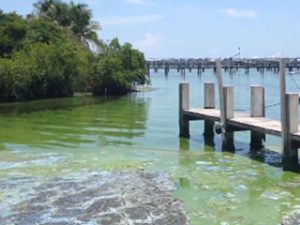
Blue-green algae clog a Martin County, FL marina, June 2016. Photo Courtesy Mary Radabaugh, Central Marine, Stuart and the Martin County Board of County Commissioners
NCCOS, through its HAB Event Response program, in response to a request from the Martin County Board of County Commissioners, has provided funds and identified experts to track the recent bloom in Lake Okeechobee that began in May and has expanded to the largest cyanobacterial bloom in the state in at least 10 years.
NCCOS provided funds to support sampling and toxin analyses in estuaries and coastal waters and provided satellite images to track the bloom. Martin County will provide monitoring results to the State Emergency Operations Center, and will release final results to the public. The NOAA funding came after the county contacted NCCOS for help in dealing with concerns for public health, particularly in county areas where the likelihood of human exposure is high, such as marinas and beaches.
Martin County is a popular tourist area located at the mouth of the St. Lucie Estuary. The bloom originated in Lake Okeechobee in May, eventually covering 200 square miles of the lake, and moving through the C-44 Canal a (St. Lucie River) into the St. Lucie Estuary as the lake was drained to protect the integrity of the dike encircling the Lake.
The Martin County Board of County Commissioners issued a formal declaration of emergency on June 29, 2016 in response to the economic, public health, and ecological impacts of the bloom.
The bloom is predominantly in freshwater, so EPA Region 4 is leading the Federal response. NCCOS HAB Event Response funding supports that response, and is directed where the bloom has moved into estuaries and coastal waters. The satellite imagery products are part of the Cyanobacteria Assessment Network (CyAN) project, a collaborative effort between U.S. EPA, NASA, NOAA, and USGS to provide early warning of cyanobacteria and other toxic and nuisance algae blooms.
From late April into May 2015 hundreds of diamondback terrapin turtles ( Malaclemys terrapin ) began dying and washing up on beaches in the western part of Long Island, New York. Simultaneously an on-going Alexandrium fundyense bloom occurred. Alexandrium produces a potent neurotoxin, saxitoxin, which is the cause of paralytic shellfish poisoning (PSP). The terrapin tissues were intact and in good condition, and necropsy did not indicate any disease, so PSP was suspected.
The NCCOS Harmful Algal Bloom Event Response Program provided emergency funding to a group of scientists and managers from Cornell University, New York State Department of Environmental Conservation, Bigelow Laboratory for Ocean Sciences, and Stony Brook University. They
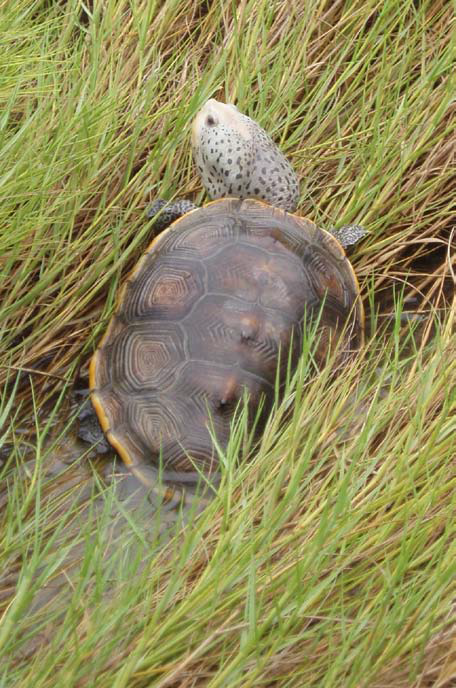
The diamondback terrapin, Malaclemys terrapin. (Credit: Andrew Coleman, NOAA National Sea Grant Knauss Fellowship Program)
collaboratively analyzed different tissues from multiple terrapins to determine if PSP likely caused the die-off and start understanding how saxitoxin affects terrapins. If saxitoxin wasthe likely cause of death, this would be the first recorded terrapin PSP event.
Due to their popularity for stews and soups, diamondback terrapins were once the subject of both commercial harvesting and aquaculture along the East Coast from Massachusetts to Texas. Their populations were depleted in the 20th century due to a combination of consumer demand, drownings in crab traps, and loss of sandy beach nesting sites to shoreline hardening.
Around mid-August, a bloom of the dinoflagellate Alexandrium monilatum appeared in lower Chesapeake Bay and its tidal tributaries. It is unclear whether the bloom originated there or was carried there by currents. Since it first appeared in the York River and at the oceanfront off Sandbridge Beach, the bloom has been observed miles into lower Chesapeake Bay, in the lower James River and its tributaries (the Lafayette and Elizabeth Rivers), and in the Lynnhaven River in Virginia. The region has never experienced such an extensive bloom of this species, which is receiving additional attention because of its bioluminescence.
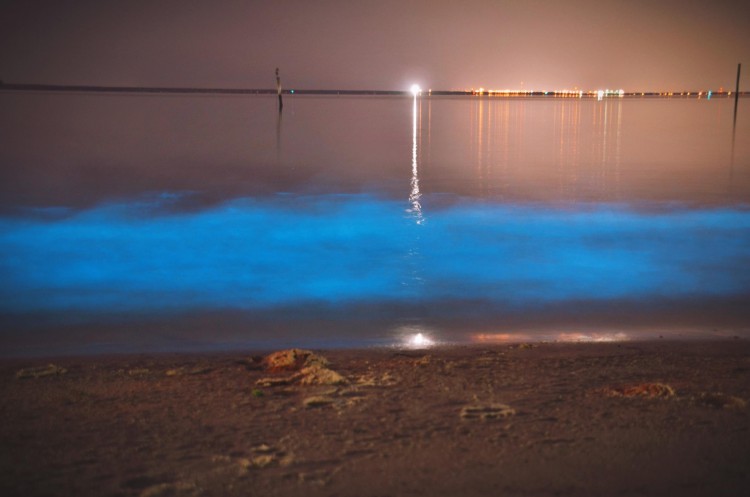
Bioluminescent Alexandrium monilatum bloom along shore of the Elizabeth River in Virginia (August 2015). Credit: Jeff Robertson and Rachel Petet, ODU
A. monilatum has no known human health impacts, but its appearance has raised concerns among bay hatcheries and restoration programs as it can produce a toxin that is lethal to fish and shellfish. Crab and small fish kills have been reported, as have high mortalities of oysters from several growers around the York River, but a link to the bloom has yet to be established.
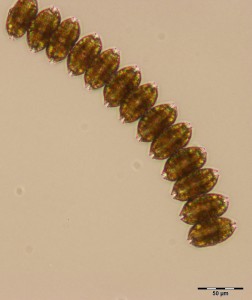
Microscopic view of Alexandrium monilatum collected from the coastal waters of Sandbridge Beach, Virginia. Credit: Todd Egerton, ODU
The NCCOS Event Response Program is funding an effort led by investigators at Old Dominion University (ODU)to assess the biotoxcity of the bloom. Scientists arecollecting bloom water samples to isolate and culture the species anddetermine potential bloom toxicity using bioassays on juvenile sheepshead minnows, blue crab larvae, and juvenile oysters. ODU scientists are coordinating with researchers from the Virginia Institute of Marine Science’s (VIMS) Department of Aquatic Health Sciences, who are also monitoring the bloom. The research team plans to share their findings with NCCOS, the Hampton Roads Sanitation District,state agencies, and other stakeholders via the Virginia Harmful Algal Bloom Task Force communications network.
The National Centers for Coastal Ocean Science (NCCOS) is providing $88,000 in emergency funds to aid Washington State to respond to an unprecedented West Coast harmful algal bloom (HAB) event.The funding supports collection and analysis of samples for the toxic algal bloom species Pseudo-nitzschia and domoic acid—the neurotoxin it produces-from beaches and offshore of Washington State.
These data, together with analysis of the oceanographic and meteorological conditions, will help identify factors contributing to the HAB outbreak and its severity, and predict whether the algal bloom will continue throughout the remainder of the year or recur in future years. The information is critical for warning the public during the upcoming popular razor clam harvesting season between late August and October.
Project partners include the NOAA Northwest Fisheries Science Center, the University of Washington, including the Olympic Region HAB Partnership, Washington State Department of Health, Washington State Department of Fish and Wildlife, Quileute Tribe, Quinault Indian Nation, and Makah Tribe, NOAA Olympic Coast National Marine Sanctuary, and the Pacific Northwest Regional Ocean Observing System, which is the Pacific Northwest regional component of the NOAA-led U.S. Integrated Ocean Observing System.
An unprecedented West Coast harmful algal bloom (HAB) continues, hurting Pacific Coast marine wildlife and causing economic losses to commercial shell fishers from Alaska to California. NCCOS sponsored scientists are participating in the event response and providing information to the public.
Recently, NCCOS sponsored scientist Dr. Vera Trainer of NOAA Fisheries joined Washington and Oregon state fish and wildlife officials in an informative interview with Oregon Public Broadcasting. The 16 minute interview, entitled ‘ Toxic Algae Bloom off the Coast is Vast,’ discusses the bloom, its causes, and economic impacts. The interview is part of Oregon Public Broadcasting’s ‘Think Out Loud’ program.
NCCOS is providing Event Response Program and grant funding to help monitor, map and analyze the toxic bloom. Most recently, whales have been reported dying in Alaska, possibly from the bloom.
Persistent concerns about toxins in Toledo, Ohio’s drinking water following August’s large, cyanobacteria bloom in Lake Erie prompted a follow-up investigation supported by NCCOS. At the time, the bloom led the City of Toledo to issue a two-day, drinking water ban for 400,000 people in Toledo and surrounding areas after drinking water samples showed high levels of microcystin – a toxin known to come from the bloom.
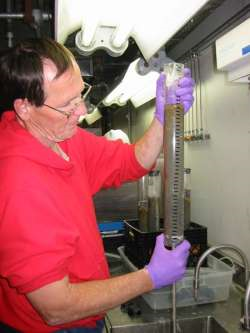
NCCOS supports the research of SUNY’s Dr. Greg Boyer, a leading expert on cyanobacteria toxins and analytical identification techniques. Credit: Greg Boyer, SUNY ESF.
NCCOS Harmful Algal Bloom Event Response funding enabled NOAA’s Great Lakes Environmental Research Laboratory to partner with a State University of New York (SUNY) cyanotoxin rapid response service lab, previously established by NCCOS, to analyze water samples taken around a water intake managed by the City of Toledo.
The SUNY lab analyzed the samples for a suite of cyanotoxins known or suspected to have human health implications. The team found elevated levels of microcystin-LR and some of its variants, which both exceeded World Health Organization guidelines, but otherwise detected no cyanotoxins.
NOAA and the SUNY rapid response lab immediately shared the findings with Toledo, the Ohio Environmental Protection Agency, and other regional utility managers in need of timely, accurate data to ensure the delivery of safe drinking water to municipalities along the shores of Lake Erie.
NCCOS is supporting the rapid deployment of self-propelled underwater robotic gliders to map an emerging red tide bloom in the Gulf of Mexico. The bloom of Karenia brevis, Florida Red Tide, was detected by an NCCOS-sponsored new modeling tool on July 23 and the Florida Fish and Wildlife Commission (FWC)promptly issued a public red tide notice alerting the public of the bloom in the northeast Gulf of Mexico about 40 miles offshore of Hernando County.
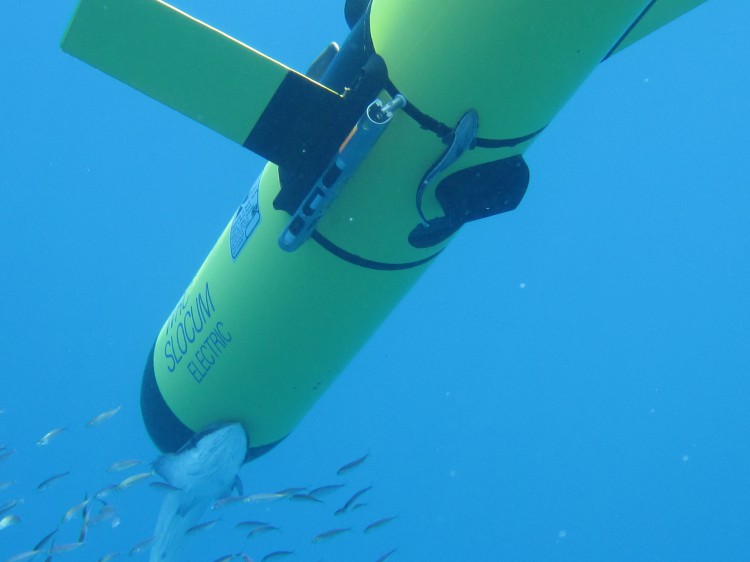
The Slocum glider that is being used to map the red tide bloom (credit University of South Florida Center for Ocean Technology).
Through the NCCOS Event Response Program, two gliders will be deployed in tandem by the University of South Florida College of Marine Science and Mote Marine Laboratory. Each glider has different sensors, depth ranges, and mission capabilities, which will provide a rapid and comprehensive assessment of bloom boundaries and depth for use in both validating model assessments and refining model predictions on bloom properties and future movements.
Red tide blooms produce toxins that can contaminate edible shellfish and cause respiratory illness when aerosolized toxins are inhaled near beaches. The economic losses to fisheries and tourism exceed $25 million annually in Florida alone, with higher costs if human health issues are considered. NCCOS event response support will provide information to the FWC to improve the state’s response and aid natural resource and public health managers.
The NCCOS Harmful Algal Bloom Event Response Program is assisting the Pennsylvania Department of Environmental Protection (PA DEP) respond to and document the first cyanobacteria harmful algal bloom (cyanoHAB ) in Presque Isle Bay, along the south shore of Lake Erie. Researchers sampled the small scale bloom near Presque Isle State Park in late July, and testing confirmed the presence of cyanobacteria species Microcystis, Aphanizomenon, and Anabaena. Additionally, these water samples had cyanotoxin microcystin levels that, based on World Health Organization guidelines, posed a high risk to recreational water users.
Based on these results, PA DEP issued a public advisory on August 2. NCCOS support, approved on August 13, will help PA DEP and park managers continue elevated cyanoHAB toxin monitoring through the busy Labor Day weekend and mobilize in-kind cyanoHAB monitoring assistance from the operational MERHAB Lower Great Lakes (MERHAB-LGL ) program. Pennsylvania Sea Grant is also providing support. Responders do not expect the bloom to extend to Presque Isle beaches, but NCCOS assistance will enable PA DEP, park managers, and local scientists to safeguard public health and document this unusual HAB event.
The NCCOS Harmful Algal Bloom Event Response Program approved a request supporting rapid response to a harmful algal bloom (HAB) in the Indian River Lagoon system of East Central Florida. Dr. Chris Gobler from Stonybrook University will work with the St. Johns River Water Management District to map the extent of the 2013 Brown Tide bloom in Indian River and Mosquito Lagoons. Dr. Gobler and his team will assess bloom effects on zooplankton grazing and the role of nutrients in promoting blooms, and help convene a September public forum hosted by the not-for-profit Marine Discovery Center. This follows a 2012 NCCOS Event Response effort that documented the brown tide in these Florida lagoons, previously found only in Texas, and that produced a new rapid, quantifiable genetic detection method.

A persistent red tide bloom off of Florida’s west coast is killing a large number of these gentle giants. Our funding of Mote’s research will help them improve rehabilitation to increase their survival rates. Credit: Tracy Colson, U.S. Fish and Wildlife Service.
In order to develop better methods of treatment, a researcher from the Mote Marine Lab received Event Response Program funds to investigate the physiological effects of brevetoxin exposure on manatees. A persistent red tide bloom of algae that produces this substance is responsible for a record number of manatee deaths this spring (2013).
Mote is working with the Manatee Rescue, Rehabilitation and Release Program, who are tending to surviving animals in their care at Florida’s Lowry Park Zoo. This funding from the National Centers for Coastal Ocean Science will help Mote collect blood samples at rescue, during recovery, and just prior to releasing treated manatees back to the wild. Mote will analyze samples for plasma toxin levels and for indicators of immune function such as inflammation and oxidative stress.
Earlier research indicates that sub-lethal exposure to brevetoxin compromises manatees’ immune systems, making them predisposed to disease.This study will provide essential information to help devise improved treatment methods and boost their chances of survival after they’re returned to their natural habitat
As a first-ever precautionary response to an unprecedented bloom of the toxic alga Pseudo-nitzschia in its waters, Maine officials have temporarily banned shellfish harvesting along part of the coast. A survey cruise and a volunteer monitoring network, both funded by the National Centers for Coastal Ocean Science, identified the bloom species and mapped where and how big it is, and how much of the algae’s toxin is in the water. They also documented other environmental conditions associated with the bloom, such as the distribution of other phytoplankton species which might compete with or hinder the spread of Pseudo-nitschia.
This information will allow Maine to assess this bloom’s threat to human health, and precisely target which shellfish beds to close. Some Pseudo-nitzschia species produce a potent neurotoxin called domoic acid that accumulates in shellfish and can cause illness or death in people who collect and eat the seafood. Commercial beds undergo extensive testing by the state to ensure the safety of restaurants’ and retailers’ supplies.
The NCCOS Event Response Program funded the Woods Hole Oceanographic Institution survey cruise and shoreline identification by the Phytoplankton Monitoring Network.
On April 5, 2012, New York announced the earliest-ever closure caused by high levels of the harmful algal toxin that causes paralytic shellfish poisoning (PSP) in New York shellfish and the first-ever biotoxin closure for shellfish beds in the Southold, Suffolk County location. Yesterday, a second marine biotoxin closure was announced in the Town of Southampton (Shinnecock Bay).
More PSP-related closures are anticipated by NCCOS-funded investigator, Dr. Chris Gobler of Stony Brook University. Last month Dr. Gobler publically discussed the strong potential for an early arrival of PSP toxin producing red tide in Long Island waters this year. The unusually warm winter had also prompted Dr. Gobler to encourage the New York Department of Environmental Conservation (NYDEC) to begin earlier sampling this year.
Dr. Gobler is partnering with NYDEC through an NCCOS Harmful Algal BloomEvent Response project to enhance HAB monitoring in Long Island Sound and help New York respond to the accelerating and expanding threat of PSP to the state’s shellfish industry.
[hr]Read the closure notices via NYDEC: Temporary Emergency Shellfish Closures (April 10),
More information:
[hr]May 2, 2012 update: The Alexandrium bloom continued to expand, forcing additional biotoxin-related closures in new locations including the Mattituck Inlet and Sag Harbor. TheNew York Department of Environmental Conservation applied for and received NCCOS event response assistance, which will ensure adequate access to toxin test kits throughout this unprecedentedly long bloom season.
In June 2010, five Alaskans exhibited signs of paralytic shellfish poisoning (PSP) linked to eating shellfish tainted with the algal toxin, saxitoxin. Two of these people died soon after onset of PSP symptoms, and the state confirmed PSP as the cause of at least one of these fatalities. Alaska has vast shellfish resources yet currently conducts no routine screening for safety of recreationally-harvested shellfish. The Alaska Department of Environmental Conservation (ADEC) uses the mouse bioassay (MBA) for regulatory testing of commercial shellfish in Alaska. However, the reliance of ADEC on the MBA has limited the agency’s ability to rapidly screen shellfish for toxins (e.g., in samples collected from the area of the reported PSP events near Haines, Alaska in 2010). Disadvantages of the MBA include the use of live animals and the difficulty of processing large numbers of samples on the same day.
Antibody-based toxin screening methods like the enzyme-linked immunosorbent assay (ELISA) have been found to be suitable for screening large numbers of shellfish and seawater samples to rapidly assess the presence of toxins. Washington State currently uses ELISA tests in conjunction with MBA testing to justify regulatory actions. NCCOS Harmful Algal Bloom Event Response Program funding was requested to help introduce rapid harmful algal bloom screening tools in Alaska. The funds helped support a training workshop on the Abraxis ELISA for PSP toxins. The workshop was held in March 2011 in Ketchikan, Alaska and was led by Kate Sullivan (University of Alaska Southeast and the Alaska Harmful Algal Bloom Monitoring Partnership) and NOAA’s Northwest Fisheries Science Center and Phytoplankton Monitoring Network. Participants included researchers and regulators from the Alaska Departments of Environmental Conservation and Fish and Game; researchers and educators from the University of Alaska system; and industry representatives, including commercial shellfisheries directors, as well as shellfish farmers directly affected by harmful algal bloom events.

